Lore's Entire Backstory Explained
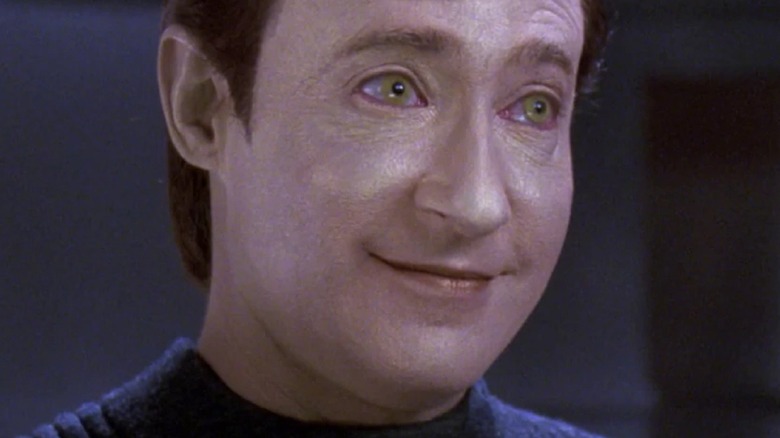
Every "Star Trek" series seems to have its own version of Spock, someone who doesn't understand (or cannot feel) emotions in the traditional sense. On "Star Trek: The Next Generation," that character is the beloved synthetic human Data (Brent Spiner), though Data also has elements of another famous "Star Trek" character. According to producer Robert H. Justman (via " The Fifty-Year Mission: The Next Twenty Five Years "), Data was envisioned as "an android programmed by Starfleet Command with all of the familiar abilities and characteristics of Spock fused with the leadership and humanistic qualities of Captain Kirk."
For seven seasons, Data played a major part in the show's explorations of selfhood, intelligence, and emotion. One plan to explore these feelings was to give Data a love interest . Her job was supposed to be repairing the ship in dangerous situations. Instead, "Star Trek" creator Gene Roddenberry decided to go down the evil twin route, and so the Lore that we know — also played by Spiner — was born. He's clever, mean, quirky, and very funny to watch, but with a lurking malevolence that's impossible to ignore. Let's take a look at his backstory.
The story of Data and Lore begins on the Omicron Theta colony, where Doctor Noonian Soong and his wife Juliana built a series of androids: Two basic prototypes, the simplistic model B-4, Lore, and Data. These were the first true fully functioning "positronic brains," which is the show's explanation for artificial intelligence in android form, and which is politicized, in various ways, throughout the canon.
The four Omicron Theta creations are known as "Soong-type" androids, because they are made in Dr. Soong's image (Dr. Soong, of course, is also played by Brent Spiner). Soong and Juliana considered all four of them their children, and Data and his fellow Soong-types are often referred to and behave as brothers. The Soongs also have a biological son, Altan Inigo Soong, graced with the same brilliance as his parents and brothers. He is introduced much later in the "Star Trek: Picard" series.
Thanks to Data's fame as the first android in Starfleet, Soong's research is further developed by Dr. Bruce Maddox, who goes into hiding after synthetics attempt to conquer Mars and synthetic life is subsequently banned. He and Agnes Jurati work with Noonian's son to create a whole community of organic androids based on Data's positronic neurons.

Creating Lore
When we first meet Lore on Omicron Theta, he claims to be an improvement on Data, but that turns out to be a lie: He is Data's older brother, not younger. Lore was born extremely advanced, with great strength and speed and high intelligence. He was also, unfortunately, unstable from the jump and he developed a serious superiority complex.
Later, Lore would claim he was rejected for being "too perfect," but the truth is that he's flawed in many ways. The people of the colony demanded that Noonian shut Lore down because he was creeping everybody out. In response, Lore secretly contacted a planet-killing space creature called the Crystalline Entity to come and destroy all life on the planet — excluding himself, of course.
Noonian eventually gave in to the demands of his fellow colonists and deactivated Lore. He stored Lore away and started work on Data instead. Since Lore's emotions were the core of his terrible behavior, Noonian decided Data would be created without all that mess — and he promised himself he would come back and fix Lore later. Noonian later came to feel bad about leaving Data's emotions out and created an "emotion chip" for him, but it took a long time for Data to actually receive and initiate it.
Meeting Lore
Unfortunately, Lore's deactivation doesn't take place soon enough for the colony to avoid the consequences of his actions, and the Crystalline Entity destroys all life on Omicron Theta. Data is discovered by the crew of the USS Tripoli years after the disaster, while Lore remained in Noonian's lab. An away team including Dr. Beverly Crusher comes from the USS Enterprise-D, and they are able to reactivate him.
Lore plays the part of a kind brother to Data at first, sharing stories about Soong, although we see in a few tics and quirks that indicate he's not entirely stable. We soon learn that he's lying about being created after Data rather than before. He isn't a more advanced model, as he would have people believe. That truth is that Soong saw some of his features were broken and resolved to work on him later, then designed the somewhat simpler Data.
Lore's true nature soon comes to the surface — he steals Data's uniform and knocks him out, planning to sacrifice the Enterprise crew to his old friend, the Crystalline Entity. Wesley Crusher is the only person who can tell the difference between the brothers, and he is frustratingly persecuted for his attempts to expose the interloper. Eventually, the ruse is discovered, and during a battle with Data and Wesley, Lore is transported into space.
The good doctor
The Enterprise is working at a Federation colony when the Crystalline Entity reappears, destroying another planet. Data and Riker are able to save almost the entire group they're working with by hiding in caves made up of a certain kind of stone. In an attempt to capture or speak to the Crystalline Entity (and in the hope of getting it to stop killing everything it comes across), an expert xenologist named Dr. Kila Marr is summoned. She seems intensely interested in the Entity, and even more so in Data.
Kila's not an android-hater: She knows Data's relationship to Lore, and Lore's relationship to the Crystalline Entity, and she thinks there's some connection between these things and the group's survival. Isn't it likely, she wonders, that the Entity would overlook the caves if they contained an ally? Were the colonists spared because Data was with them? In the end, it's revealed that Dr. Marr's son was killed in an attack by the Crystalline Entity, and she uses the Enterprise's attempts to communicate with the Entity to first torture and then destroy it. The crew is horrified by this waste of life, and Dr. Marr herself seems to go completely off the rails.
Lore's niece
Did you know that Lore once had a niece? After attending a cybernetics conference, an excited Data returns to the Enterprise to build a Soong-type android child of his own: Lal, which means "beloved" in Sanskrit. At first, the child is genderless and faceless, throwing off Deanna Troi and Geordi La Forge entirely. But the child is intelligent and clearly alive — or at least sentient — in the same sense as Data himself. Lal refers to Data as "father," just as Data and Lore do with Dr. Noonian Soong. Data creates Lal knowing all the things that can go wrong, and he's determined to improve on Soong's failures with Lore.
Eventually, Lal chooses a form: Human female. The crew easily goes along with her choice of gender and race, just as they are okay with Data's claims to fatherhood. After a few attempts at schooling, in which she mostly unnerves the other children, Lal takes up a job in Ten Forward under Guinan's guidance and begins learning the ins and outs of social behavior. After a Starfleet Admiral arrives to take her away, Lal's fear response kicks in and causes a cascade failure in her neural net. Ultimately, Data is unable to save his daughter, and they say goodbye.
The emotion chip
Lore drifts in outer space for almost two years before his rescue by a Pakled trade ship. Soon after, Noonian — alive, but dying — sends out a homing signal to summon Data to his new lab on Terlina III. It also summons Lore, who arrives with much resentment, but shows genuine concern when Noonian reveals that he is dying.
However, this family intimacy only lasts for so long. It all goes out of the window when Lore finds out why Noonian sent out the beacon in the first place: He has created an implantable chip that will allow Data to feel human emotion. Lore is, of course, unable to comprehend that Data's makeup and background make him more ethically sophisticated, and therefore able to deal with having emotions without going unstable like Lore.
Lore gets jealous about this, even when Noonian explains that Lore didn't get a chip because he thought he was still deactivated. This isn't a great excuse, since it leads back to the fact that he was deactivated in the first place. He takes the chip for himself by impersonating Data, but Soong explains that the chip was made specifically for Data and that the chip is just going to make him even more unstable, which it does — he eventually kills Noonian because of it, disappearing into the cosmos.
Hugh the Borg
While Lore is gone and presumed dead — or at least no longer a problem — the Enterprise-D discovers a gravely injured Borg drone at a crash site in the Argolis Cluster. Beverly Crusher fights for his life and they bring the Borg back to the Enterprise for care and study. It's the right thing to do, but Geordi La Forge understandably doesn't trust the Borg, named Third of Five. He treats the patient like a machine and keeps his guard up. Soon enough, the Borg starts showing signs of individuality and ego, necessary for a personality to form.
The Borg are a cybernetic race of former humans (and others) who have been assimilated into a vast hive-mind collective, ruled by a Queen. They operate as a group, and can hear each other's thoughts at all times. Beverly and even Geordi come to care for their subject, giving him a human name: Hugh. Captain Jean-Luc Picard suggests they send Hugh back to the collective as a kind of Trojan Horse, hoping his individuality will infect his brethren like a virus. But what does all this have to do with Lore?
Lore's Borg army
One year later, we learn the results of the Hugh gamble. The Borg ship that retrieves Hugh from the Argolis crash site does indeed become more individualist — an effect that causes them great consternation, as they are used to operating as a unit, without personal thoughts. They are adrift and disconnected from the collective when Lore comes across them, ripe for control, and assumes leadership of the group.
Lore gives the Borg individual names but restricts their freedoms — his rule is a totalitarian one. The Borg become his fanatical followers, shouting slogans and threatening violence. They don't even bother assimilating people into the collective anymore, they just kill. Lore is now the leader of a fascist movement made up of formerly mindless drones.
Eventually, he starts experimenting on them, trying to replace their once-human, organic brains with positronic brains like he and Data have. These experiments do not go well, resulting in mutilation and death. What Lore really wants to do is experiment on human subjects, and he plans on using Data to acquire them.
Lore's death
Lore's Borg army begins an attack in Federation space, luring Data in. Lore can now use his emotion chip to moderate Data's own emotions and perceptions — when Data kills a Borg, he feels a perverse pleasure afterward, an alien sensation to him. Lore decides to deactivate Data's ethical subroutines, and Data deserts the Enterprise to follow his brother.
Geordi and Picard are captured, and Data does experiments on Geordi, putting his crewmate through a terrible ordeal. Between bouts of torture at Data's hands, Geordi is able to teach Picard how to modify a Borg interlink transceiver to reboot Data's ethical programs. This won't decrease Lore's power over his emotions, but he'll at least have the option of acting on them.
Lore continues to manipulate Data for some time, fighting against the ethics rising in his subroutines, but eventually Data recoils from the cruelty and futility of their experimentation. The Borg on whom Lore has been experimenting all die horribly, and this is what pushes Data over the edge. He attacks, deactivates, and dismantles Lore, whose last words are: "I love you, brother."
Lore's mother is also an android
Data meets and becomes close with Dr. Juliana Tainer — formerly Juliana Soong, Data and Lore's "mother" — and they play music together. After an accident it becomes apparent that Juliana is also a Soong-type android. She's more developed than both of them, which bodes well for Lore in terms of potential future appearances.
Juliana comes with a holographic chip of Noonian, which Data activates on the holodeck and learns that it's a message directly to him. Soong's hologram explains that the original, organic Juliana was injured in the Crystalline Entity's attack on Omicron Theta, and by the time Soong made it to Terlina III, she was in a coma. Soong built her a positronic matrix and loaded her mind into it, creating a special shutdown loop in case she ever discovered she was an android.
Data wrestles with the decision of whether or not to tell her about her true nature. Eventually, he opts to leave her be, telling Juliana that she was the love of Soong's life, despite the fact that he was sometimes cold toward her — he could never quite get over the fact that she was a replacement for his real wife. They agree to meet again on Atrea and Data calls her "mother" in a touching moment.
Data and Lore's other brother makes an appearance
Lore's now-damaged emotion chip is back in Data's hands, but he's wary of using it due to the instability and actions of his brother. It will be years before he installs the chip, causing a lot of drama during the movie "Star Trek Generations," but not going haywire like Lore would. For the remainder of his appearances, Data possesses emotions, and his arc becomes one about learning to control them, which he eventually does.
In "Star Trek: Nemesis," the tenth film in the series, Data comes up against another older brother, B-4. While Lore's appearances always stage him as being on par with (or perhaps even more capable than) Data, in this case, the roles are reversed — B-4 is a much simpler machine. However, a lot of the same hijinks ultimately ensue, with Data and B-4 impersonating each other and B-4 eventually betraying the crew.
In order to save the Enterprise, Data valiantly offers his own life to destroy a Reman Warbird, and Jean-Luc Picard ends the film discussing Data and his sacrifice with a repaired but still confused and unsophisticated B-4.
Lore is coming back for the final season of Star Trek: Picard
This slide contains spoilers for "Star Trek: Picard."
In the first season finale of "Star Trek: Picard," the titular character briefly visits with Data in hologram form after downloading the remains of his consciousness from B-4. Positronic brains and neural nets, Dr. Maddox discovers, are capable of "fractal neuronic cloning," using just a single positronic neuron to recreate the whole of the consciousness. This is part of an arc that saw the fifth Soong brother — the biological son of Noonian and Juliana — create a planet of Soong-type androids, including two off-world sleeper agents, sisters who may not even know they're androids. These Soong-types are highly advanced, with all of Lore's abilities and none of his problems, and it's exciting to think about what artificial life could look like in the future of the show.
In 2022, it was revealed that Brent Spiner is set to reprise the role of Lore in the third and final season of "Star Trek: Picard." Fans already knew that Spiner was going to be involved, but his return as Lore wasn't confirmed until New York Comic Con, where a new trailer was released . One thread of the series has been Picard's grief and acceptance of Data's death, so Lore's appearance is likely to stir a lot of emotions in the titular character. There was another big Lore reveal at NYCC : The character will be part of a new comic book series called "Star Trek: Defiant." The comic is set before "Star Trek: Nemesis" and sees Lore join the crew of the Defiant, led by Worf. Lore already has a fascinating backstory, and it is set to be filled out even more in the near future.
Star Trek: Who Is Lore?
Taking a close look at the evil twin of one of Star Trek’s most loved characters, and what their presence in the new Picard trailer might mean.
Star Trek is filled to the brim with fantastically crafted characters, both heroes and villains. They slot in perfectly in their complex universe, acting as a futuristic allegory for topical issues at the times when the shows were made. Out of all the villains the franchise offered up, one of the more memorable, but often overlooked by the writers, is that of Lore.
This insidious android is the ‘evil’ cyborg twin brother to fan favorite character Data. With his surprise appearance in the new season 3 trailer for Picard , it seems his time in the limelight is not over. So for those who don't know, who exactly is he, and what happened to him in between The Next Generation and his appearance in Picard ?
RELATED: Star Trek TNG Cast Returns For One More Adventure In the Picard Season 3 Trailer
All great stories and character arcs start with a name. ‘Lore’ is a rich name with deeper meaning, especially when compared to his brother’s given name. Both Lore and Data are different types of information, but Data is far more factual and scientific. Lore, meanwhile, often relates to stories and mythology, handed down through generations. Data is inherently logical and factual, harder to falsify. Lore can be twisted and changed as stories pass from one mouth to another. It is also linked to traditions and religion. This makes perfect sense for why Roddenberry , a secular humanist with strong opinions about science over faith , would make Lore a villain The character would embody everything he disliked about religion: alluring and interesting, but dangerous.
Like Data, Lore was created by Doctor Noonien Soong. Also like Data, he was, rather egotistically, built in Soong's own image. He was the doctor's fourth attempt at a fully functional android, and the first he made with a fully functional positronic brain. Lore was, at least at first, the perfect creation. He was advanced in both strength and intelligence, and also fully sentient. This latter aspect was good thing on paper, but as his personality developed, it made him much more dangerous. While Data was created afterward, his older brother was actually more advanced. Lore possessed complex emotional programming – something that Data was always desperate to replicate, but often fell short of or missed the point entirely, much like Seven of Nine .
Removing emotion from Data was no mistake. Over time, Lore became more and more emotionally unstable, starting to display signs of malevolent behavior. He started to see himself as better than the humans in the colony where he and Soong lived, aware of his superiority and tiring of those he believed to be beneath him. He grew more and more degrading towards them, until the humans began demanding that Soong deactivate Lore. Lore proclaimed that was because they were envious of his perfection. Soong, though, eventually saw the darkness in his creation. He finally chose to shut Lore down and dismantle him, but not before Lore set in motion his own plan for revenge. He knew he would be deactivated, so he contacted a powerful space-born entity known as the Crystaline Entity. He offered to sacrifice the planet and those who lived there to the Entity in exchange for his own survival.
While Soong set about creating Data, he placed Lore into storage for many years. He always meant to return, and fix the issues with his emotional programming, but never did. Soong managed to finish Data, but soon afterward, the Crystaline Entity appeared, responding to Lore’s call. It destroyed all life on the planet, leaving just Data and the dismantled, deactivated Lore ‘alive.’ Starfleet found and rescued Data, and Lore remained in storage until one fateful TNG episode, “Datalore.”
In the episode, Lore was found and reactivated by Beverly Crusher and the crew of the Enterprise-D. Some truly classic Lore shenanigans ensue. He quickly returns to his nefarious ways, culminating in a telenovela-style twin swap with him and Data. The crew eventually work out what he has done and, in a rather un-Star Trek-like conclusion, he is transported into the cold embrace of space . Here, Lore floats around for two years until he is finally picked up by a passing trade vessel, and returned to Doctor Soong, who is revealed to have survived the attack.
Soong re-actives Lore, and they argue. Lore is angry with his ‘father’ for never trying to fix him, and instead replacing him with Data. His anger softens somewhat when he learns that Soong is gravely ill, but is reignited when he learns that Soong has summoned Data as well. He plans to fit Data with a new and improved emotion chip. Combined with an emotionless upbringing where he learned the factual difference between right and wrong, this would prevent the problems that exist with Lore. Data arrives, and Lore once again plays the identical twin card . He takes Data’s place, hoping Soong's invention will ‘fix’ him, and Soong installs the chip in his head instead. Despite his intentions, the chip does the opposite, as it was never designed for him. It sends his emotions into overdrive, sending him into a rage that causes him to mortally wound Soong before escaping.
There is more to Lore’s story, like the time he partnered up with the creepy Borg and turned Data to the dark side, but his story ends in failure. Data, realizing his brother was too far gone to be helped, manages to stun and then deactivate him. Lore's last words were ‘I love you brother’ in a surprisingly emotional moment from the reccurring baddie. He is dismantled, and the emotion chip Soong is removed and returned to Data, who would later install it in himself. Data declares that Lore has been ‘permanently deactivated,’ his positronic net damaged beyond repair. His body/parts are most likely stored at the Daystrom institute.
While he may have been beyond repair during TNG, a lot of scientific discoveries and developments have been made by the time the Picard series comes along. With Maddox’s fractal neuronal cloning technique seemingly working fine, it might provide the perfect reactivation explanation for Lore's return in the new season.
MORE: Star Trek: The Fan Backlash To The J.J. Abrams Films Explained
An Episode of Star Trek: TOS Inspired One of The Next Generation's Best Villains
"The Enemy Within" saw Captain Kirk split in two, a concept that was revisited in The Next Generation to create one of Star Trek's best villains.
- Many of Star Trek: The Next Generation's Season 1 episodes were updates of The Original Series.
- A similar premise to "The Enemy Within" provided The Next Generation with one of its greatest recurring villains.
- Lore could have been a one-off antagonist, but an android with Data’s strength and intelligence minus his morality was a villain too tempting to not use over again.
As a long-running franchise, Star Trek has created many excellent villains. From god-like alien entities like Q and Trelayne, to the augmented human despot Khan Noonien Singh and even simple con artists like Harry Mudd, Star Trek has shown that evil can be found anywhere in the galaxy. Sometimes, malevolence can even wear a familiar face, causing havoc in the most subversive ways possible.
In Star Trek: The Next Generation Season 1, a romantic episode that had been written for Lt. Cmdr. Data was changed to an evil twin story instead. Taking inspiration from a Season 1 episode of Star Trek: The Original Series , the writers created Data's evil opposite twin brother Lore. What no one could have foreseen at the time was how enduring this new antagonist would be, or how much he would evolve beyond the episode that inspired his creation.
TNG's 'Datalore' Inverted The Original Series Episode 'The Enemy Within'
Why star trek ships' maintenance corridors are called jefferies tubes.
In Star Trek: The Next Generation 's first season , the series' writers crafted an episode about Data finding love with a female android whose job was to fix the ship under the most hazardous conditions. The episode was scrapped, however, when it turned out to be too costly to make, so series creator Gene Roddenberry proposed an 'evil twin' story that would be less expensive to replace it. With a limited shooting schedule, rewrites had to happen fast, and the story that was created bore a striking resemblance to Star Trek: The Original Series , Season 1, Episode 4, "The Enemy Within."
In The Original Series , the Enterprise's transporter malfunctions and splits Captain Kirk into two people, each representing a different aspect of his psyche: the good and bad. Star Trek: The Next Generation , Season 1, Episode 13, "Datalore," turned out to be an updated version of the classic episode. With the premise that Data's creator, Dr. Noonien Soong, had constructed another android before him, the The Next Generation story was able to delve deeper into the android officer's origin while simultaneously telling an entertaining evil twin tale. While "Datalore" was able to update the story of "The Enemy Within" with improved special effects and a more complex look at the nature of human emotions, it also covered a lot of the same territory as The Original Series episode.
Evil Kirk Had a Few Things In Common With the Sinister Android Lore
Gene roddenberry created star trek, but who is the woman behind the franchise.
Though the explanations for Star Trek 's evil doubles between The Original Series and The Next Generation were completely different, the Season 1 doppelgänger episodes of both series had many similarities. When Captain Kirk's dark half attempted to force himself onto Yeoman Janice Rand, he received three deep scratches on his left cheek, visibly distinguishing him from the original Kirk. The Next Generation replaced the scratches with a more active visual distinction for Data's brother. Shortly after being reassembled and reactivated in the Enterprise-D's sickbay, Lore demonstrated a facial tick on his left cheek to differentiate him from Data.
Later in each episode, the evil doubles marked their twins with the same peculiarities and disguised their own. Evil Kirk applied makeup before scratching his opposite's face, while Lore used a tool to correct his twitch and then created one on Data's cheek. They each also rendered their doubles unconscious in order to be free. Yet, "Datalore" was hardly a complete retread of "The Enemy Within," as the evil versions of Data and Kirk had very different motivations and personalities. When Kirk's darker self materialized in the Enterprise's transporter room , he was disoriented and filled with dark impulses, but he was still James T. Kirk.
All of Kirk's memories were the same, even if his impulses were entirely self-motivated. Lore, on the other hand, was a distinctly different android from Lt. Cmdr. Data. Evil Kirk was chiefly interested in his own survival and maintaining command of the Enterprise, while Lore had aided a deadly and powerful alien entity in destroying the colony he'd been living on and planned to do the same to the galaxy class Enterprise. Further, while Captain Kirk used the transporter to reintegrate both his good and bad selves into the more complex man audiences were just getting to know, Data used his ship's transporter to rid the Enterprise of his double. The solution turned out to be impermanent as Lore would later return to make life difficult for his brother again.
Data's Evil Brother Returned to Star Trek as a Threat to the Federation
Star trek directors don't get enough credit for how they shape the shows.
While its many similarities to "The Enemy Within" could make "Datalore" seem a little uninspired, Brent Spiner's performance as his own evil twin made the prospect of Lore's return far too tempting for The Next Generation 's producers and writers. Thus, when a homing beacon summoned him and Data reunited with his creator, Dr. Noonien Soong , in Season 4, Episode 3, "Brothers," the return of his unstable brother was as big a thrill for fans as it was a shock for Starfleet's only android officer.
It didn't take long for Lore to return to his malevolent and duplicitous ways, overpowering Data and tricking and thrashing their terminally ill father out of jealousy for his favoring the younger android. Lore made his escape before the away team that had gone to collect Data arrived, carrying in his system the emotion chip that had been meant for his brother. Lore's actions in that episode teased the high probability that he would return once more, and much like recurring Star Trek villain Khan, the crew of the Enterprise would come to know his wrath. Just like Captain Kirk's two disparate versions in "The Enemy Within," Lore had complicated feelings regarding his emotionless little brother.
While he resented Data and felt the younger android was inferior, Lore couldn't help but want to have some kind of relationship with him. As such, in his final appearance on Star Trek: The Next Generation , in Season 6, Episode 22 and Season 7, Episode 1, "Descent, Parts I and II," it wasn't enough for Lore to try to destroy the Federation using a ship full of Borg who'd been disconnected from the Collective; he had to manipulate Data into joining him. When Data finally came to his senses and defeated and disassembled Lore, it seemed that was the end of the commander's twin brother, but Star Trek has a history of resurrecting popular characters .
Lore returned for what may have been the last time in Star Trek: Picard , Season 3, as part of a new artificial lifeform comprised of the minds of Data, their less-advanced predecessor B4, Altan Noonien Soong and himself. Unwilling to share the new body, Lore tried to destroy Data, only to be outwitted by his brother. Like Kirk with his evil self before him, Data embraced Lore at the end, deleting his malignant personality while retaining his knowledge and memories. It seems likely that audiences have seen the last of Lore, though with new Star Trek series under consideration , a return in some form isn't out of the question. One thing is certain, however: if Kirk had never faced "The Enemy Within" in The Original Series , The Next Generation would have missed out on one of its most enduring villains.
The Star Trek universe encompasses multiple series, each offering a unique lens through which to experience the wonders and perils of space travel. Join Captain Kirk and his crew on the Original Series' voyages of discovery, encounter the utopian vision of the Federation in The Next Generation, or delve into the darker corners of galactic politics in Deep Space Nine. No matter your preference, there's a Star Trek adventure waiting to ignite your imagination.
Lore (Star Trek)
You may be looking for the Australian fanzine Lore .
Lore is a recurring character in Star Trek: The Next Generation , played by Brent Spiner . He is a prototype android brother of Starfleet's Lieutenant Commander Data (who serves as second officer cum science officer aboard the USS Enterprise ).
Lore was created by Mad Scientist , Dr. Noonien Soong . Lore's emotional programming was very advanced. However, he began displaying signs of emotional instability and malevolence, leading Lore to see himself as superior to the human colonists. He frightened the other colonists, who demanded that Soong deactivate him. Lore later claimed that they saw him as "too perfect", and were envious.
Found in Soong's lab in pieces, Data and Geordi LaForge reconstruct Lore and reawaken him. After an attempt to dupe Data's colleagues, Lore was transported into space and drifted alone for months, until recovered the Pakleds. Lore stole an emotion chip intended for Data and eventually subverted a small collective of Borg . He was again defeated by the Enterprise crew and deactivated by Data.
In the movie Star Trek: Nemesis , another Soong-type android prototype is discovered, known as B-4 .
Doctor Altan Soong , in the streamed series Star Trek: Picard was a male human scientist who lived in the 24th century. Another self-described " mad scientist ", he was the son of Noonian Soong, and visually identical to Lore, Data and the B-4. Many fans speculated that Altan, or the gold-skinned female "synth", Sutra , would turn out to be a resurrected and disguised Lore. But this was not to be.
An aged Lore eventually makes a surprise return in Season Three of Star Trek: Picard .
In Fanworks
Fanzines focusing on the character include:
- The Body Electric series and its sister zine , The Bawdy Electric (1992-95).
- Continuum #2 (1989) - Lore by Janet Lawn .
- D-Tales (1998) - Android Rights and Wrongs by Eva A. Enblom .
- Data Base v.2.1 (1993) - First Lore by Kate Orman .
- Data Entries #3 (1988) - A Question of Humanity by Jamie Lawson .
- Data Entries #15 (1992) - The Price of His Toys by Lyn Gunn .
- Eridani #16 (1992) - MisQued by Cyndi Bayless Overstreet .
- Grip #30 (1988) - Bored With Lore by Diana Fox .
- Grip #45 (1993) - Lore's Lure by Marjorie Russel .
- Klingons over Kiron III (1991) - The poem by Ian McLean , Lore and Order , has since been reprinted online on the author's blog.
- Lore and Disorder (1996).
- Make It So #12 (1993) - You Lived Among the Colonists? , poem by Christine Carr .
- Make It So #14 (1993) - Lost and Found by Debbie Lee .
- Make It So #18 (1993) - The Positronic Dream Made Flesh by Carol Sterenberg .
- Make It So #19 (1994) - Some Kind of Justic by Carol Sterenberg .
- Reassembly (1997) by Denise Tanaka .
- Sons of Kiron III (1991) - contains the story A Lore Unto Himself .
- Volumes of Forgotten Lore (1992) by Jean Lorrah .
The members of Astrex , a Star Trek club in Australia, were amused when a major character in the then-new Star Trek: The Next Generation was coincidentally named for their long-running newsletter Data . A few years later, members voted to title their new club fiction fanzine ... Lore .
A regular feature in Data Entries is Dear Lore , a parody "agony aunt" column, in which Lore answers readers' questions.
A parody Lore Fan Club is featured in issues of Electronic Male .
Fanart Gallery

Lore and Data, and the Crystalline Entity, cover of Sons of Kiron III , art by Maria Papadeas

Internal art from Lore and Order , Klingons over Kiron III by Paul "Breeze" Beck

Pest Control Devices by "Annie" at Seawave 's Lore Fan Art

Lore and Data, cover of Data Entries #20, art by Alicia Galka
In Nonfiction
The first TNG zine , Data Entries , was a newsletter about Data, Lore and Brent Spiner, who played them. It was launched in 1987 and ran to 45 issues; later issues also included fanfiction.
Other similar newsletters include Electronic Male , with 10 issues.
- Universal Lore by Seawave/Tanya Dean
Fannish Communities and Archives
- Datalore by Seawave ( squidge.org )
- Lore Fan Art by Seawave ( squidge.org )
- Lore (Star Trek) fanworks on AO3
- Star Trek TNG Characters
Navigation menu
- Movies & TV
- Big on the Internet
- About Us & Contact
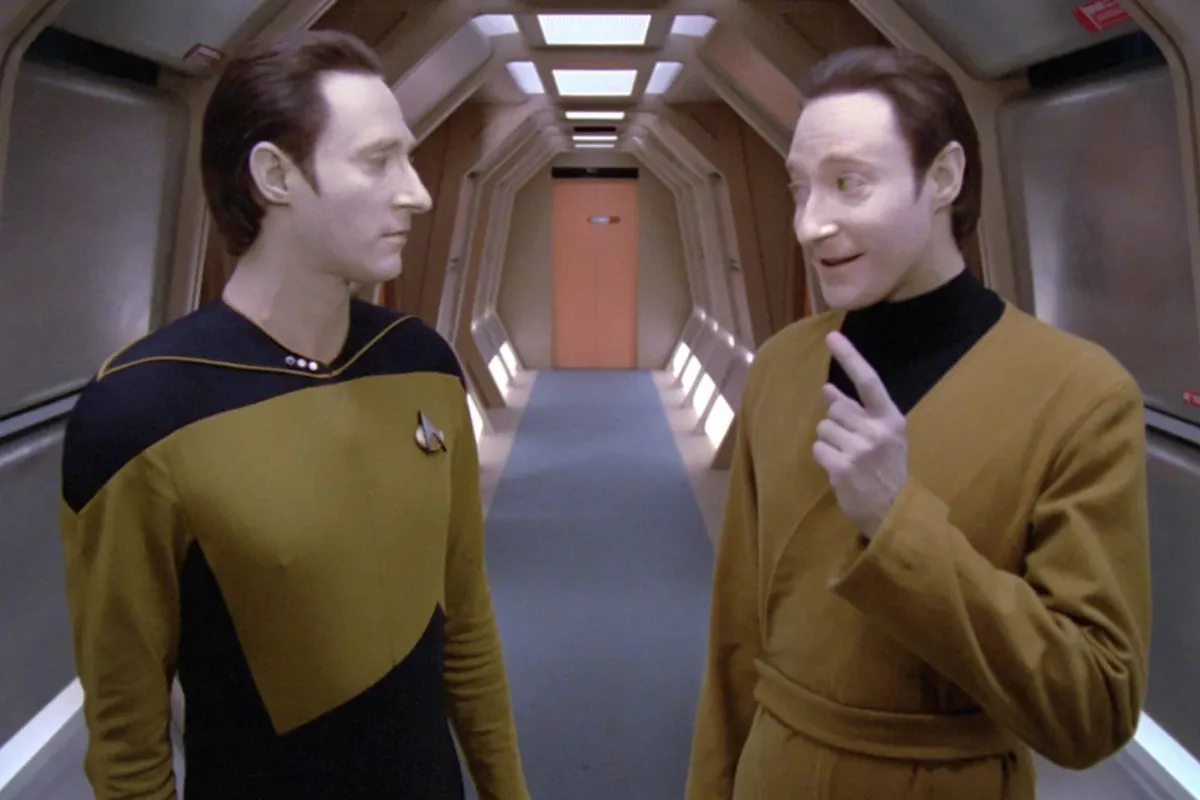
Data’s Double: Revisiting Lore From ‘Star Trek: The Next Generation’
If you’re even a little familiar with Old Trek , then you’ll know about Lt. Commander Data ( Brent Spiner ), the android officer who served under Picard on the Enterprise . But what about his brother, Lore (also Brent Spiner)? Data was supposed to be the only one of his kind, so the arrival of a secret brother came as a surprise, and though Lore was in comparatively few episodes, his impact on the Star Trek universe was significant. Here’s everything you need to know about the character some consider to be Data’s evil twin.
Who is Lore?
Like Data, Lore was created by Doctors Noonian and Juliana Soong at the Omicron Theta Colony. The fourth of their android children, Lore was the first to have a fully functional positronic brain and function with greater-than-human intelligence. However, unlike Data, Lore was created with the ability to feel the full range of human emotions—something that turned out to be a disaster. Possessed of superhuman abilities but with none of the empathy, ethics, and emotional regulation that organic beings develop over their childhood, Lore was the equivalent of a super-powered toddler, and convinced of his own superiority to all other beings.
The destruction of the colony
Considering him a threat, the other colonists pressured Soong into shutting Lore down. Knowing what was coming, Lore managed to summon the Crystalline Entity , a being that consumes all organic life it encounters, hoping it would arrive and wipe out the colony before Soong capitulated—and content that if it didn’t, then at least he would have his revenge on the community that murdered him. Soong did have enough time to dismantle Lore and put him into storage with the hope of being able to fix him later, as well as finish constructing Data before the entity arrived—leaving the brothers alone and offline on an empty world.
Lore’s discovery
Data was found by the initial Federation team investigating the destruction of the colony because he was laid out in the open and ready to be switched on, but Lore was overlooked because his body had been left in storage. It was only when the Enterprise returned to the colony years later that Lore was discovered by Data and reawakened by the ship’s Chief Engineer, Lt. Commander Argyle, and Dr. Crusher. This only served to increase Lore’s resentment; not only had his father created a replacement, but that replacement had been rescued while he’d been left to languish in a box on an empty world.
Antagonistic relationship with the federation
After a failed attempt at passing himself off as another benign, human-positive android, Lore first tried to steal Data’s identity, and when that didn’t work, he summoned the Crystalline Entity again in an attempt to kill the crew of the Enterprise. While this failed and left Lore stranded and floating in space for several years, it marked the beginning of a hostile relationship with the Federation and a complicated one with his brother.
The emotion chip
Lore’s reappearance (and the reveal that he was no longer trapped in the vacuum of space) came about when Dr. Soong, who had escaped the destruction of the colony and set up on Terlina III, attempted to summon Data via a homing beacon. The beacon was also visible to Lore, and he arrived along with Data to discover their father dying. Though distraught by this news, Lore’s anger took over once again when he learned that Soong had only intended to summon Data—because he’d decided Data was ready to experience emotions without turning out like Lore, and had designed an emotions chip to enable him to do so. Furious that their father was once again favoring Data, Lore stole the chip and killed Soong, only for his mental state to deteriorate further after installing it because it wasn’t designed for his brain.
Later, Lore was able to use the chip to remotely project emotions into Data after somehow switching off his ethical subroutines—the aspects of his programming that would have prevented him from becoming like Lore once given the ability to feel emotions. Filling him with anger and hatred, Lore’s plan briefly worked, and the two of them joined forces before the Enterprise was able to reverse what he’d done.
Lore was able to take over a rogue Borg cell that had broken away from the hive. First encouraging their newfound individuality, he began conducting experiments on their brains, replacing organic sections with positronic parts and making them more violent in the process. Then he began pointing them at the Federation, trying to provoke a confrontation with the Enterprise so he could get his hands on Data, and causing a lot of death and destruction in the process.
His relationship with data
All of this might make it seem like Lore hated Data, but their relationship was more complicated than that. Initially feeling anger and resentment towards him, seeing him as their father’s golden child and the being who would replace him, Lore began to long for a brotherly relationship with Data—or perhaps he had all along. The purpose behind everything Lore did with the Borg and the emotion chip wasn’t for revenge against Data; it was to have Data by his side as his brother, transformed into a person who could understand him, and who he was finally able to understand in return. Even after Data finally shot Lore, shutting him down permanently, Lore’s final words before he went offline were, “I love you, brother.”
(featured image: Paramount)
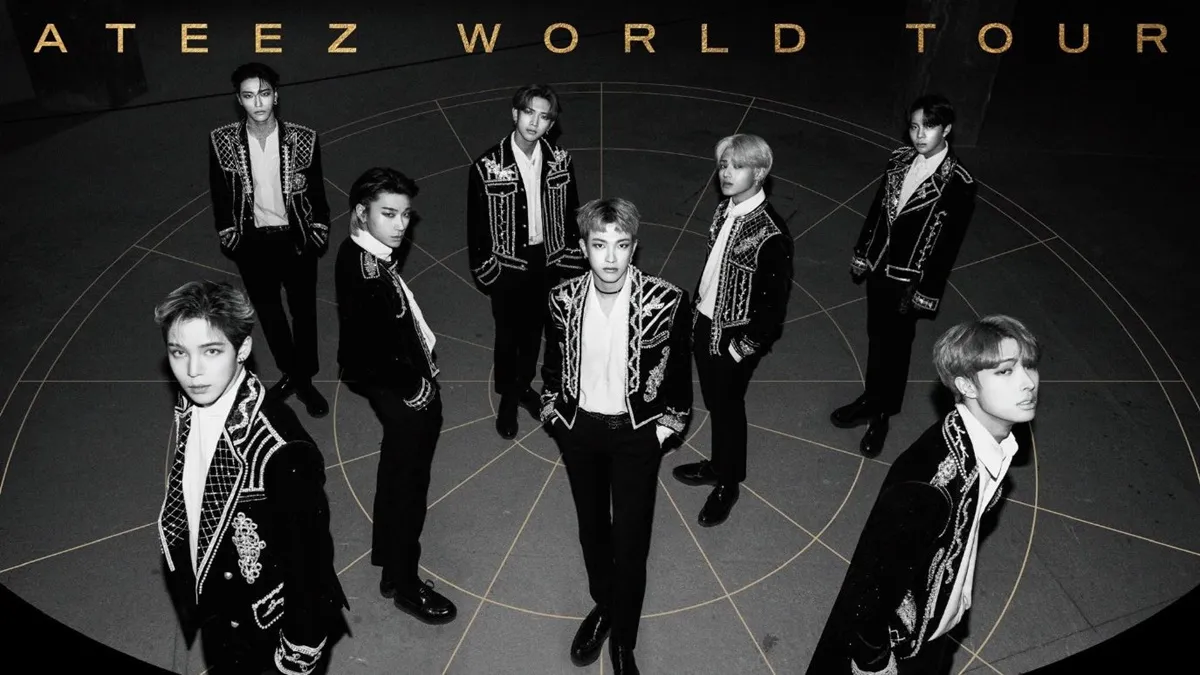
- View history
Below are the 166 questions and answers for the Path to 2409 daily trivia, available at Starfleet Academy from Commander Viala for “History 102: Alpha Quadrant Midterm” and Klingon Academy from Loresinger Ch'toh for “Learning the Lore of the Empire” .
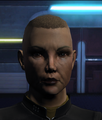
Commander Viala is the historian at Starfleet Academy
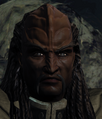
Ch'toh is the Loresinger of the Klingon Academy

Commander Viala outlines the objectives for Starfleet officers
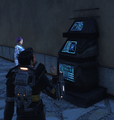
Midterm can be taken at this computer console
last edit: -- Cyberchip ( talk ) 01:13, 24 December 2015 (UTC)
- 2 Playable starship
- 3 Reputation System
- More to Explore
- Series & Movies
Published Feb 2, 2023
Android Ancestry: Examining the Soong-Type Line
In celebration of Brent Spiner's birthday, we're taking a look at Dr. Noonian Soong's legacy.
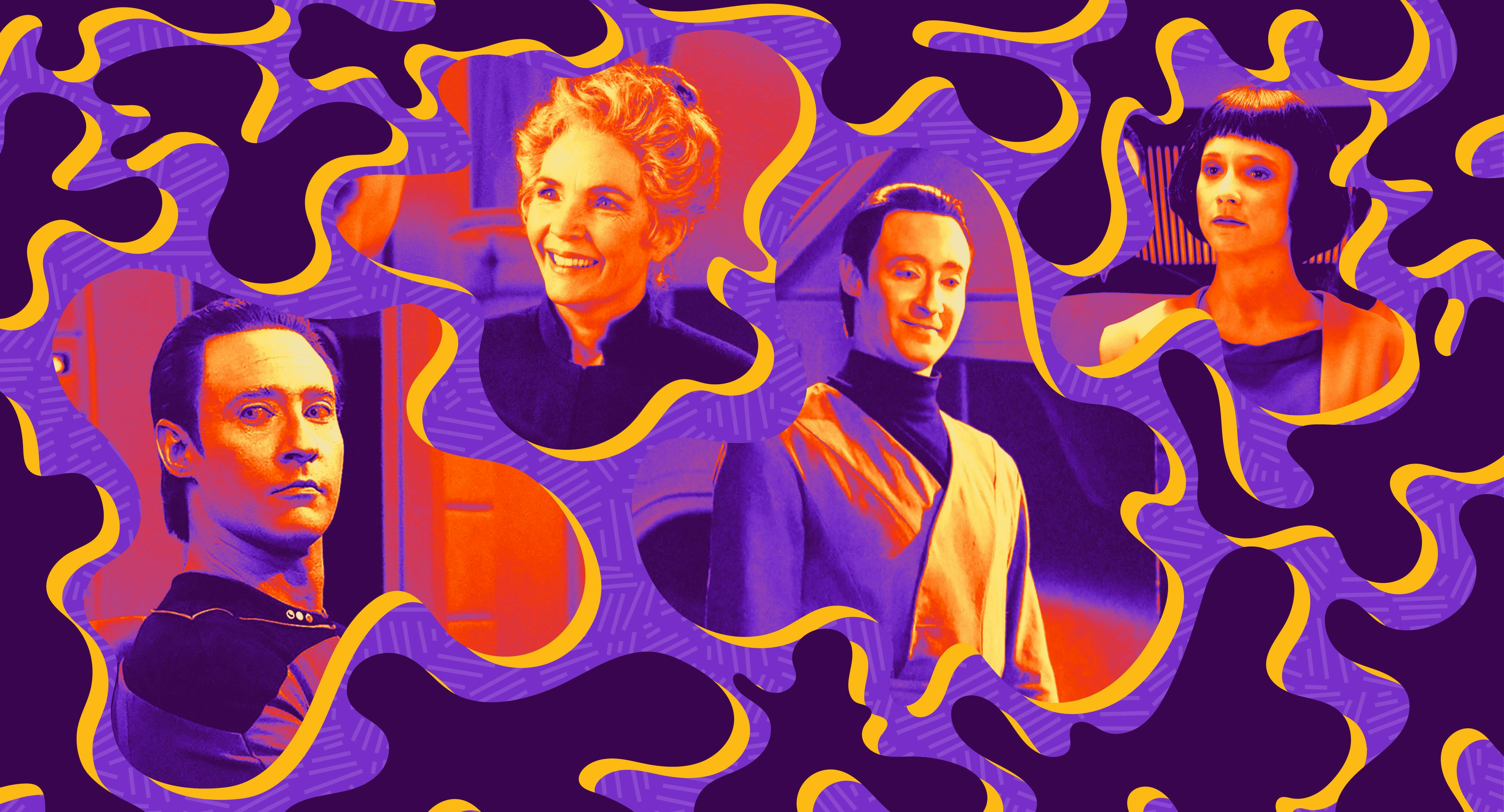
StarTrek.com / Rob DeHart
Brent Spiner has portrayed various roles across the Star Trek universe, from members of the Soong family, his primary role as Data, and to a number of android brethren.
In celebration of Spiner's birthday, we're going to examine the line of Soong-type androids, created by Dr. Noonian Soong . These androids, possessing revolutionary positronic brains, includes two early prototypes, four operational models built by Soong himself, and one version constructed by Data himself.
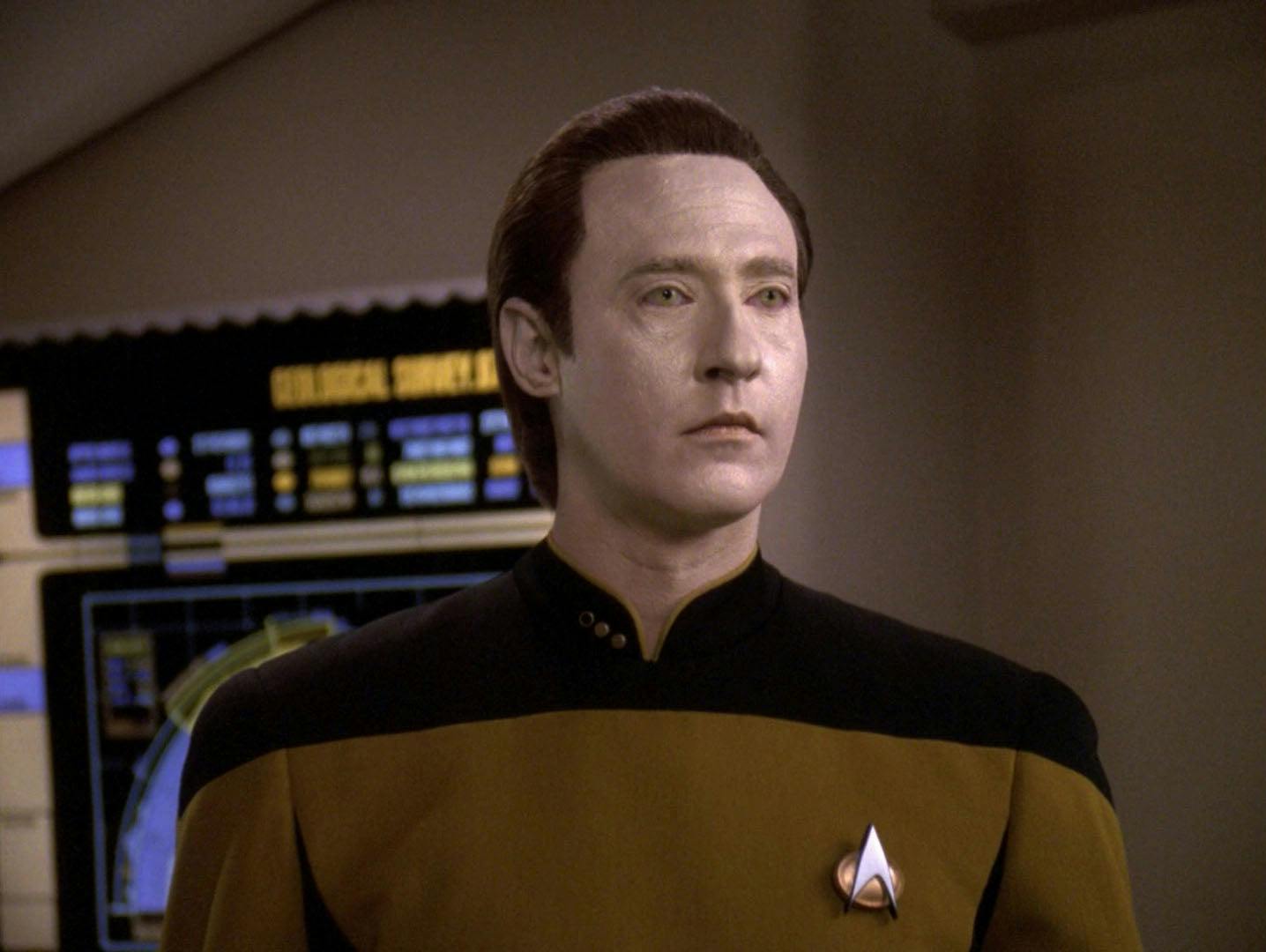
StarTrek.com
The most well-known Soong-type android, Data was discovered by a Federation starship and subsequently chose to join Starfleet. Throughout his tenure aboard the U.S.S. Enterprise-D and U.S.S. Enterprise-E , Data endeavored to explore what it meant to be human, pondered his place in the universe, and even defended his rights as a sentient individual. The android established close relationships with the command crew, owned a cat named Spot, considered Geordi La Forge to be his best friend, and became fascinated by theatre, music, and art .
Data eventually obtained an emotion chip that Dr. Soong had designed for him, and its installation granted him access to a wide-range of feelings. Despite sacrificing his life to save Captain Picard from Praetor Shinzon, Data’s consciousness continued to exist in a simulation that Dr. Altan Soong and Dr. Bruce Maddox crafted from a copy of Data’s memories and a single one of his neurons, which the two scientists also used to create the Coppelius androids. Following a brief chat with his former captain, Data requested that Picard end the simulation, thus ending Data’s historic existence.
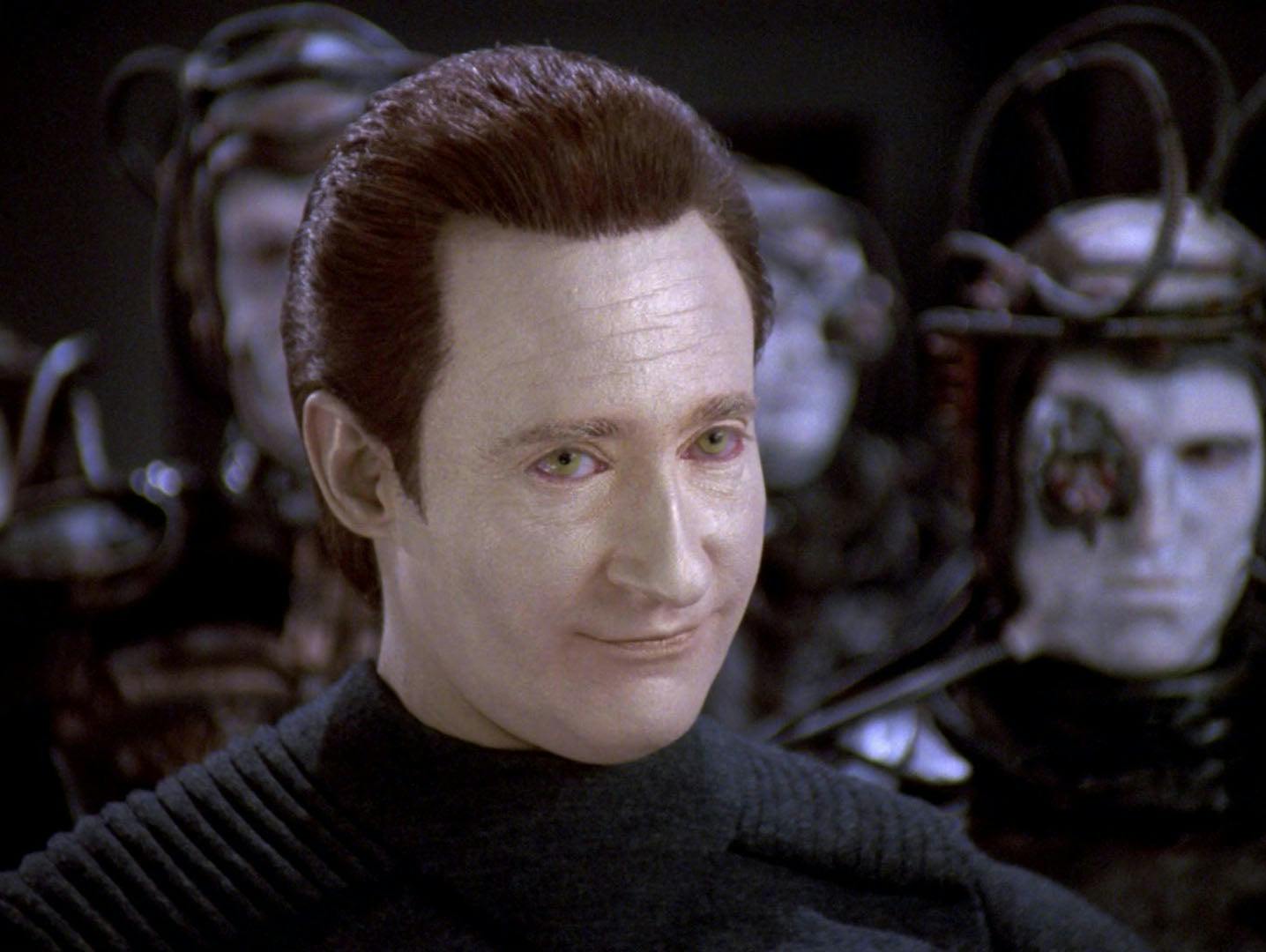
Although he was Data’s predecessor, Lore possessed an insight into human emotion that Data lacked, but these feelings often expressed themselves in unstable and troubling ways. Noonian Soong deactivated Lore, who was later found and brought back online by his “brother,” Data.
Unfortunately, Lore’s talent for deception remained, as he collaborated with the Crystalline Entity, stole Data’s emotion chip, and even organized wayward Borg drones to reign terror across the quadrant. Data captured and shut off Lore, making the Borg plot Lore’s final scheme. Or so it seemed...
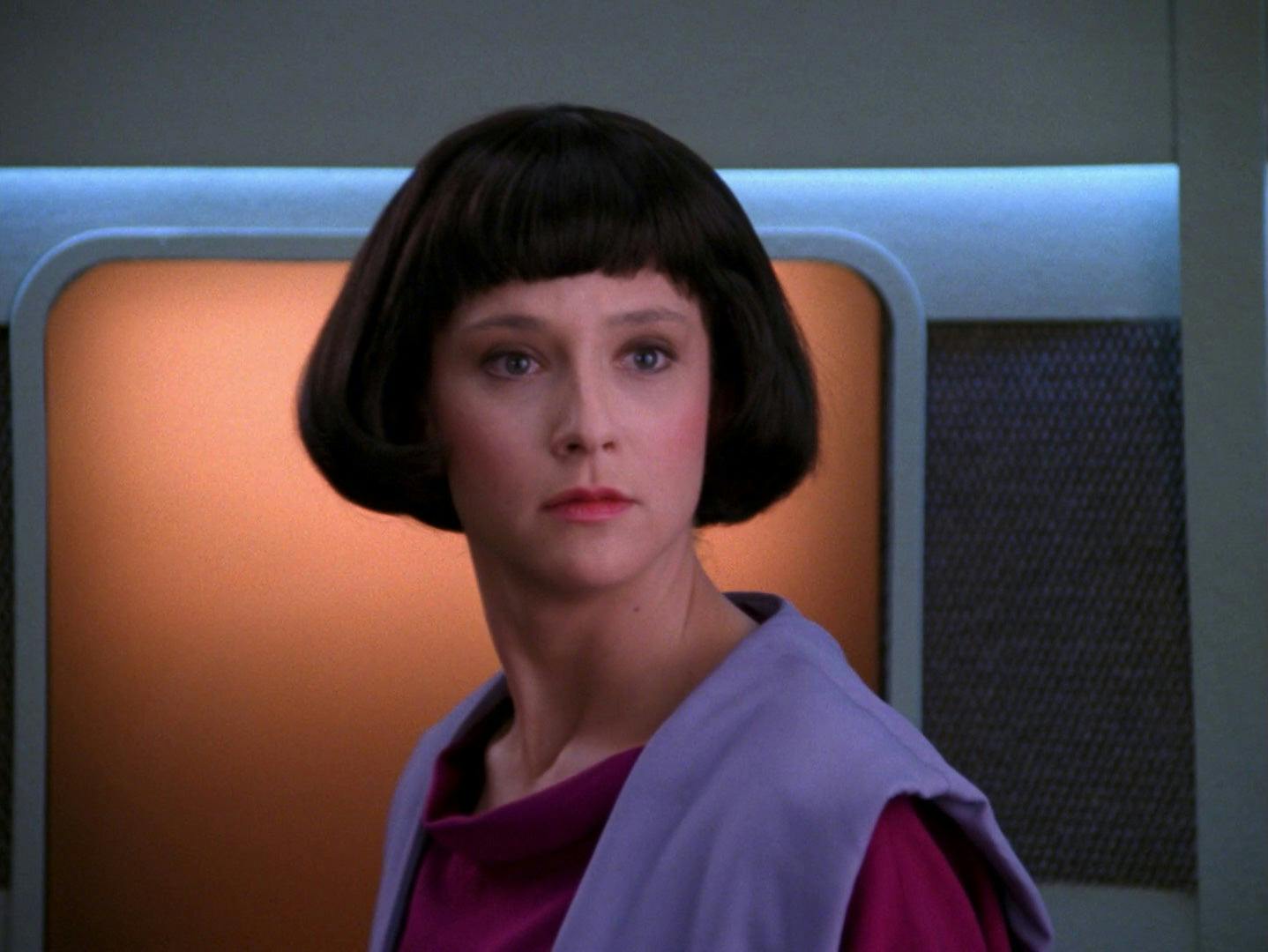
In a bid to procreate, Data employed his own positronic brain’s layout and created an android who he considered to be his child. In a remarkably progressive move, Data recommended that his progeny choose their own species and gender. Opting to be a human woman, the android known as Lal quickly ingratiated herself to Data’s friends, though Captain Picard was a bit conflicted that he was not briefed prior to Lal’s “birth.” Starfleet took an even stricter position, arguing that Lal was its property and needed to be studied so more Soong-type androids could be manufactured.
As the only Soong-type android not assembled by Noonian Soong, Lal represented a spectacular achievement, especially as she demonstrated an ability to express emotion. The familial bliss did not last long, however, with the failure of Lal’s neural net prompting a complete neural system failure. In her dying moments, Lal declared her love for her father. Unable to share in the emotion, Data nevertheless desired to keep Lal with him, so he incorporated her programs back into his own, permitting Lal’s memories to live on.

Juliana Tainer
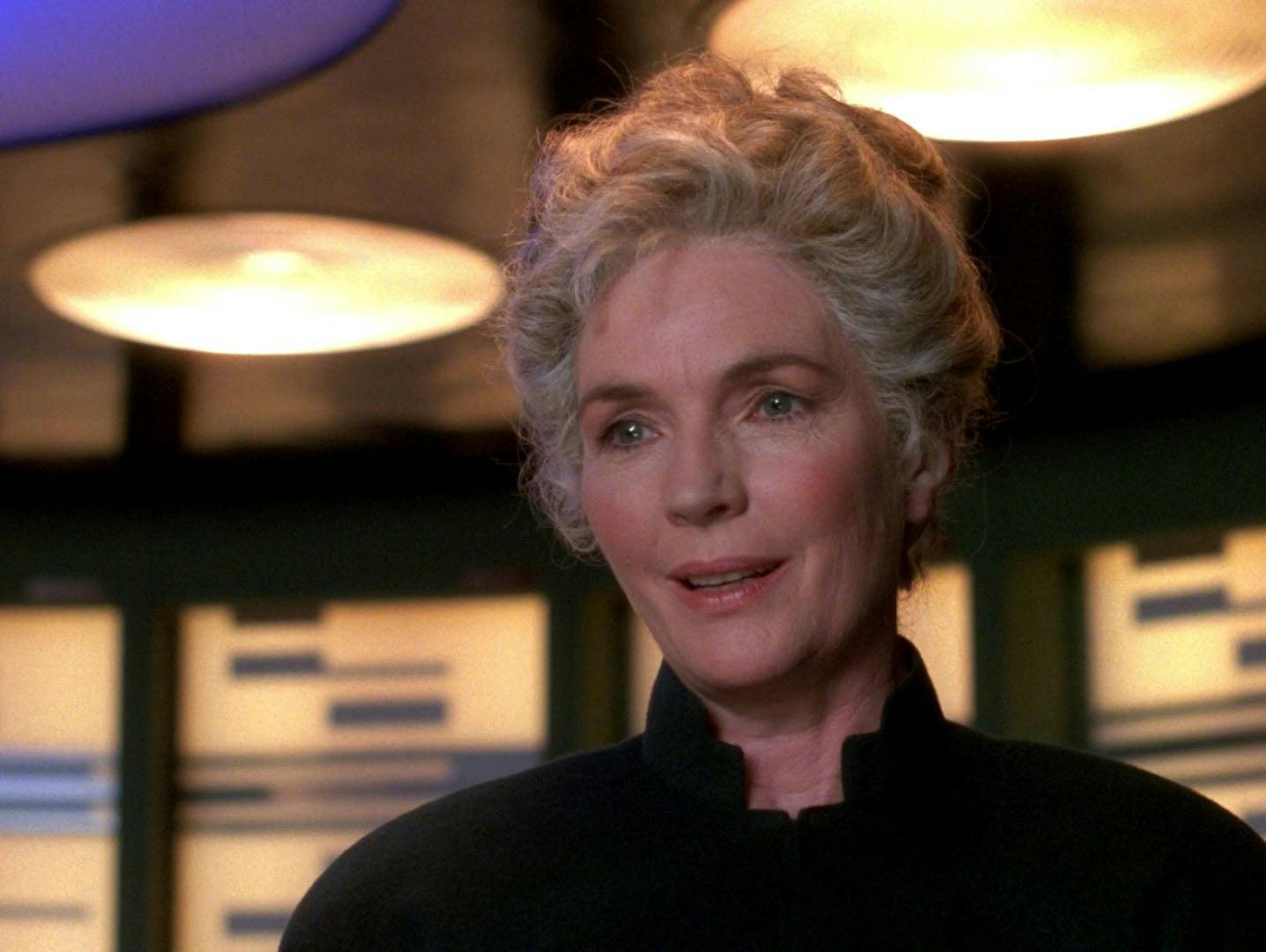
When Noonian Soong’s wife Juliana O’Connell was mortally wounded by the Crystalline Entity, the cyberneticist transferred her memories into a positronic matrix prior to her death. Soong soon activated the Juliana android , which was built to mimic human features, hide its artificial nature, and eventually pass away after living a full life. Not even Juliana knew about her true identity, as she believed she was the real Juliana O’Connell. The android eventually left Soong and remarried.
A chance encounter with Data granted Juliana the opportunity to get to know her “son,” but it was not long before an accident helped Data deduce that Juliana was actually an android. A Noonian Soong holoprogram embedded in Juliana explained her lineage and requested that Data not reveal her artificial ancestry to her. Data spent much time weighing the choice, deciding that it was in Juliana’s best interest to keep Noonian’s secret to himself.
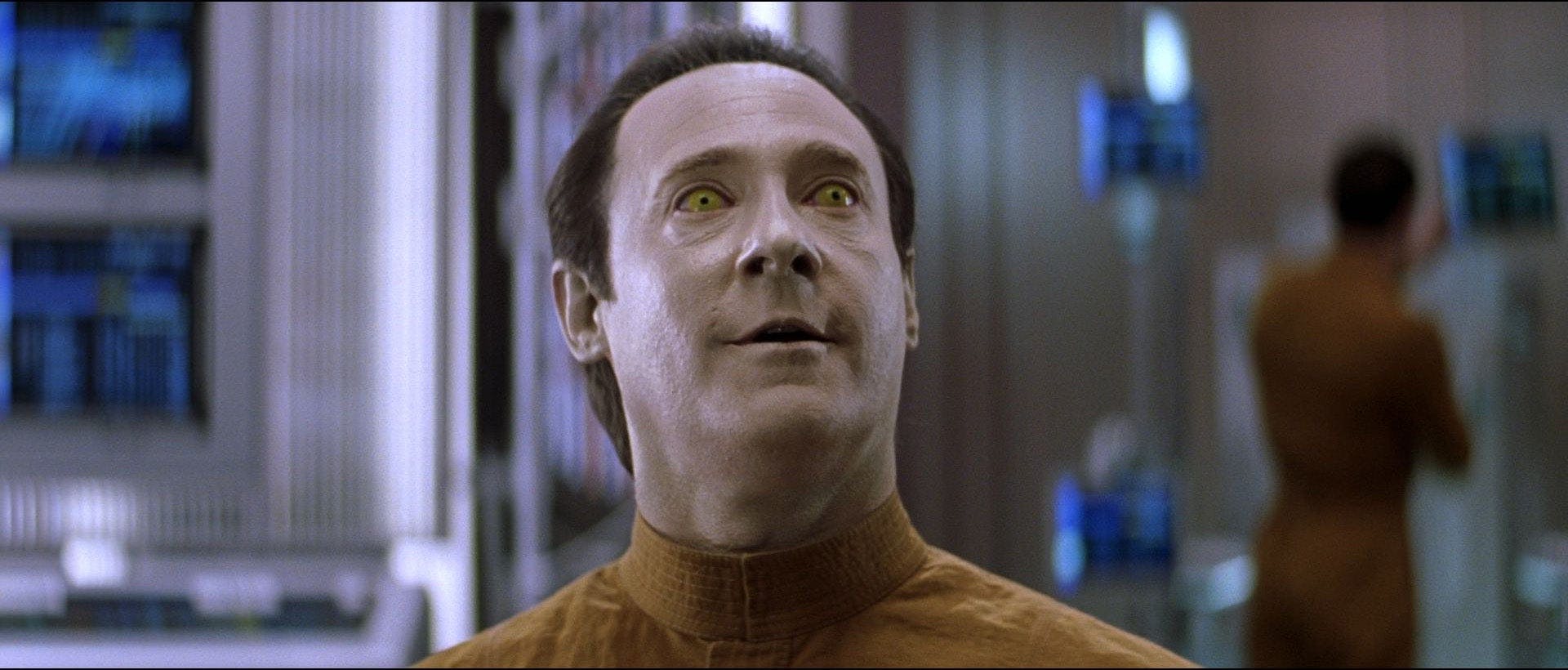
A previously unknown model that pre-dated Lore, B-4 was a less sophisticated variant found by Praetor Shinzon, who attempted to use the android to steal information from the Enterprise-E ’s computer. While Data tried to transfer his memories into B-4, the elder android did not seem to have the capacity to process the files.
In the wake of Data’s death, there was some hope that his personality could reemerge in B-4. Once this did not manifest, B-4 was disassembled and stored at the Daystrom Institute , where Picard visited his components in 2399.
Brent Spiner's Star Trek Characters, Ranked
Jay Stobie (he/him) is a freelance writer and consultant who has contributed articles to StarTrek.com, Star Trek Explorer, and Star Trek Magazine, as well as to Star Wars Insider and StarWars.com. Jay can be found on Twitter and Instagram at @StobiesGalaxy.
Stay tuned to StarTrek.com for more details! And be sure to follow @StarTrek on Facebook , Twitter , and Instagram .
Get Updates By Email

- April 28, 2024 | Interview: ‘Star Trek: Discovery’ Writer Carlos Cisco On Unmasking The Breen And Revisiting The ISS Enterprise
- April 26, 2024 | Michael Dorn Wanted Armin Shimerman To Play The Ferengi That Worf Killed In Star Trek Picard
- April 26, 2024 | Podcast: All Access Gets To Know The Breen In ‘Star Trek: Discovery’ 505, “Mirrors”
- April 25, 2024 | Prep Begins For ‘Star Trek: Strange New Worlds’ Season 3 Finale; Cast And Directors Share BTS Images
- April 25, 2024 | Jonathan Frakes Sees Opportunities With Streaming Star Trek Movies, Weighs In On “Filler Episodes”
Recap/Review: ‘Star Trek: Discovery’ Reflects On Its Choices In “Mirrors”
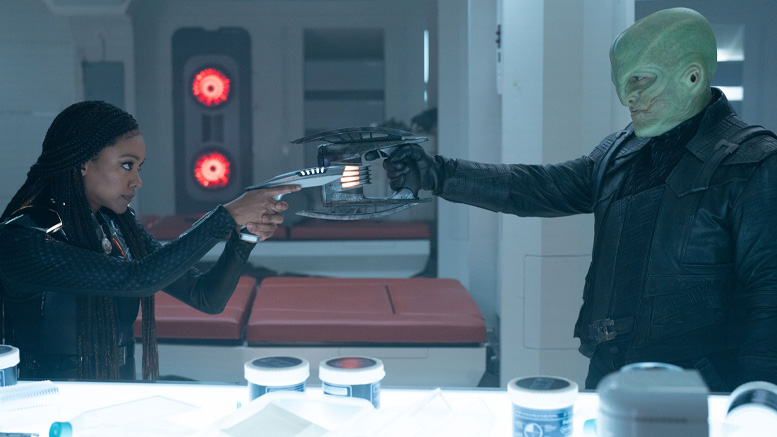
| April 25, 2024 | By: Anthony Pascale 116 comments so far
Star Trek: Discovery Season 5, Episode 5 – Debuted Thursday, April 25, 2024 Written by Johanna Lee & Carlos Cisco Directed by Jen McGowan
A solid episode with plenty of lore and character development gets weighed down with a bit too much exposition.
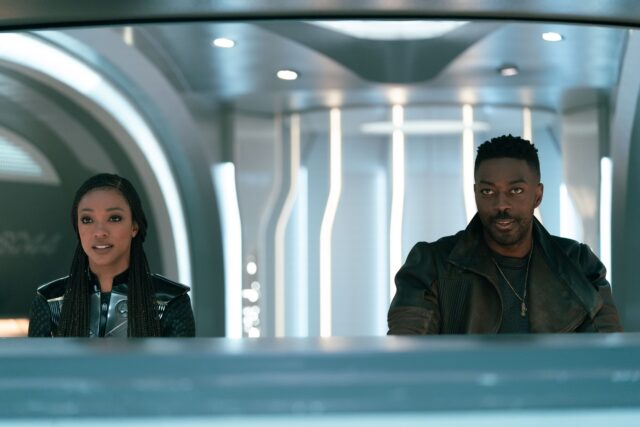
No, I didn’t kiss you in the past last week, what makes you say that?
WARNING: Spoilers below!
“Maybe we’re not so different.”
As the crew regroups following the time bug incident that lost them 6 hours, they try to trace the trail of their main rivals in the search for the Progenitor tech. Book takes this time to reflect on the choices he has made in life and how it isn’t too late for Moll; perhaps he can redeem the daughter of his mentor and namesake Cleveland Booker. Stamets and Tilly figure out the trail didn’t disappear into nowhere: Moll and L’ak went through a wormhole. The aperture isn’t big enough for the Disco, so the captain assigns herself to shuttle duty—over the objections of her new XO, who is still struggling a bit. After a little bonding over old Kellerun poetry, she leaves him with “I know you can lead this crew” and heads off with her ex. Returning to their old banter, including some teasing about what happened during her time tour last episode, Book and Michael head through the wormhole. Things get really choppy as they fly through exotic matter “deaf and blind,” losing comms with the Disco, and dodging debris. Skilled piloting and good ol’ Starfleet engineering saves them, but things aren’t so hot for Moll and L’ak, whose ship is spotted cut in half. Their only hope for survival is another relatively intact ship that looks familiar. A 24 th -century scientist hiding a clue in this pocket dimension on a shipwreck from another universe makes as much sense as anything. It’s the ISS Enterprise—and that’s no typo. If the “Mirrors” title wasn’t clue enough, the ISS does it: Things are about to get Terran, again.
After docking, Michael and Book make their way through the mess of a ship to the bridge with more playful banter. The warp drive has been bricked and all shuttles and escape pods are gone, very out of character for ruthless Terrans. They track three quantum signatures in sickbay, but start with a trace in the transporter room, which looks more like a makeshift refugee camp. A chronicle reveals the crew mutinied after the Terran High Chancellor (aka Mirror Spock) was killed for making reforms. A certain Kelpien rebel leader (aka Mirror Action Saru) led refugees to the Prime Universe, where they abandoned ship. While Book expositions, Michael puts a piece of her badge (and its important Prime Universe quantum signature) in a locket she finds. Pay attention BTW, or you will be confused later. In sickbay, they find Moll and L’ak, Moll and L’ak, and Moll and L’ak—until they take out the holo-emitters so the four former couriers can face off for real. Book tries the “I knew your father” gambit and is immediately rebuffed by Moll’s serious daddy issues. The baddies figure they have the clue so they have all the leverage, but Michael uses that locket as a bluff, claiming she has the real clue. Still, no deal with the Federation is good enough because they need the Progenitor tech to get rid of an Erigah… a Breen blood bounty. That’s right, L’ak is Breen. Holy refrigeration helmet , Batman.
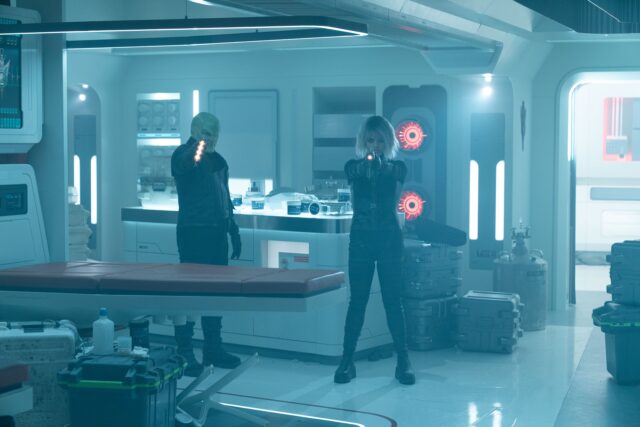
Mirror McCoy was a bit of an evil pack rat.
“You both still have choices .”
Cut to a series of Burn-era flashbacks when Moll was delivering dilithium to the Breen Imperium. The “bucket heads” are not amused by the wisecracking courier who gets into a fight with one of them, but she turns the tables, revealing she knows he’s a disgraced member of the royal family—and she even knows his name. It’s L’ak, of course. He is intrigued by her plan to skim more latinum, getting payback for being humiliated for this cargo duty demotion. Soon enough, this unlikely pair is hooking up between cargo containers and he even takes off his helmet to show her his face, as well as his “other face.” It turns out the Breen have two: the one we have been seeing with L’ak and a glowing eyed translucent one. Later, the star-crossed romance is threatened when Moll is drawn to the lure of even more latinum by delivering to the Emerald Chain. Before they can sort out if he should join her, Uncle A-hole shows up, not happy about his nephew’s little interspecies exchange program. He’s also not cool with L’ak using that old face and not the “evolved” glowy face. L’ak is given one chance at redemption: Kill Moll. He picks door number 2, killing some guards but sparing Primarch Ruhn, who declares the Erigah. L’ak knows this means they will never stop hunting him, but Moll is all-in on being a fugitive, so they escape together. Ah, true love.
Back on Mirror Enterprise, the standoff devolves into another quick firefight as the Breen/Human duo chooses not to take the offered off-ramp before going too far down the bad guy road. Moll and Book end up outside force fields that pop up around sickbay, so she reluctantly agrees to a ceasefire. The current Cleveland Booker tries again to connect, but Moll only has bad memories of a brutal childhood of abandonment after her Cleveland left her on her own at age 14. L’ak is all she has. L’ak feels the same about Moll, telling Michael that he would die before being separated, but seems open to the idea of them sharing a cell in the Federation pen. On the bridge, Book pivots to use his relationship with Michael to connect, but Moll’s need to get back to L’ak means no waiting for computer hacking, so she starts yanking out wires. The resulting short does lower the forcefield, but now the ship is out of control. Their shuttle is flung off with the jolt and there’s only eight minutes until the Big E is squished in the little wormhole. Book takes his final shot, handing over his phaser and telling Moll she is the only family he has left. She finally relents and they head to sickbay, where Michael and L’ak have resumed fighting. The captain gets the upper hand and ends up with the clue L’ak was holding and the Breen is left with a knife in his side, but impressed by the locket bluff. Moll arrives and is super pissed, so the Disco duo makes a quick exit before things escalate into yet another phaser fight. This former courier couple’s double date is over.
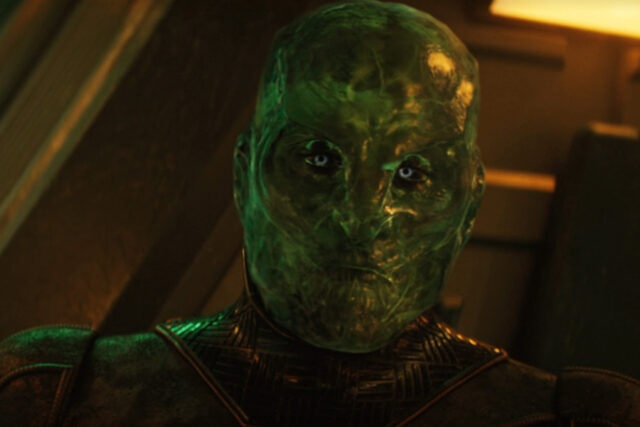
Uh, can you go back to the other face now?
“Maybe we can shape our own futures too.”
As Moll tries to patch up her boyfriend, Michael and Book work through the problem on the bridge, deciding that the tractor beam as their only hope. Over on the Disco, they detect an oscillating pattern, 3-4-1-4, which means something to Rayner. He now wants the nerds to figure out how to open the wormhole aperture big enough for a ship, offering kegs of Kellerun booze for the best idea. Adira sparks a team effort and Rayner rallies around the crowdsourced solution involving a hexagon of photon torpedoes. “We are only going to get one shot at this. I trust you will all make it count, red alert.” That’s the stuff. With what may be the last seconds of her life, Michael lets Book know she shared a “happy” moment with his past self during the whole time bug incident. Discovery fires the torpedoes and the crew is surprised to see the ISS Enterprise emerge at the last minute from the permanently collapsing wormhole. Everyone releases their tension as the captain informs her crew they saved her… but why is the Enterprise about to fire? A warp pod is launched! It’s Moll and L’ak. Before you can say “plot armor,” they escape to another episode. The captain returns to the Disco to tell Rayner she’s impressed with how he handled the crew during her time away, and he tells her how impressed he was with her subtle “3-4-1-4” message using the Kellerun “Ballad of Krull.” Alien poetry FTW!
In the background of the episode, Tilly has been noticing that Dr. Culber seems out of sorts. Everyone else leans on him, so she offers to be a friendly ear. As things wrap, Hugh takes her up on her offer over drinks at Red’s, admitting that ever since he was possessed by a Trill a few episodes back, he has been feeling a bit off, and he’s beening having some trouble coming to grips with the quest they are on with questions “so big and impossible to grasp.” He is not sure his matter-of-fact husband will understand what Tilly points out is a sort of spiritual awakening. This thread is left unresolved, unlike Adira’s mini-crisis of confidence: They were losing their science mojo due to guilt over the time bug, but got it back through Rayner’s tough love and being the one to come up with the hexagon of torpedoes solution. Things wrap up with Michael and Book looking over their prize, the latest piece of the map and a mysterious vial of liquid hidden inside, ready to set up the next episode once Stamets unlocks its secret. Burnham is starting to see a pattern with these clues and how the scientists who left them were trying to teach lessons along the way to the successful questers. The clue hidden in the ISS Enterprise came from Dr. Cho, a former Terran junior officer who later became a Starfleet Admiral. This happy ending for her and the others from Saru’s band of Mirror refugees fills them with hope as they can’t wait to find out what they will learn when they put the map together. There are just 2 more map pieces and 5 more episodes to go.
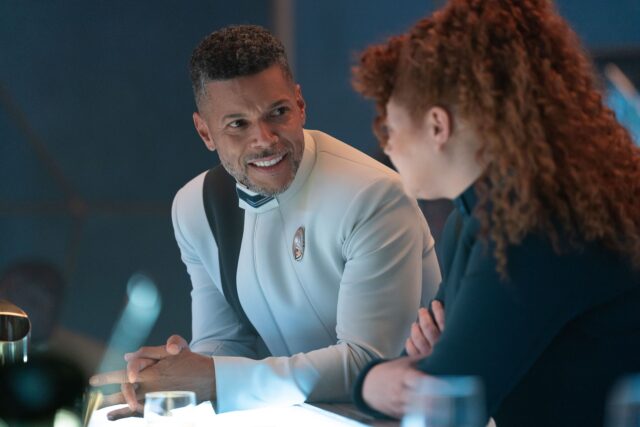
I think I have a thing for being possessed—no judgment.
Love stories
This halfway point episode is a bit of a mixed bag. Strong performances were a highlight, bringing extra life to welcome character development for both heroes and villains. But valiant attempts to expand upon franchise lore got weighed down in overly complicated exposition. And for an episode with a strong (and yes, often repeated) theme about choices, some of the directorial choices just didn’t work, potentially leaving some audience members confused or requiring a second viewing to follow the narrative. On the other hand, the episode carried on the season’s reflection on Discovery’s own lore and the evolution of its characters. David Ajala stands out as the episode MVP as he shows Book’s struggle to navigate the emotional complexities of his own choices and those of Moll while desperately trying to forge a new family connection. While some of the action scenes in this episode felt a bit perfunctory, the show is still getting better (for the most part) in finding moments for those character sidebars to talk about their emotional journeys and relationships. That was especially important in this episode, which took a closer look at how the events of the season are impacting some of the key romantic pairings of Book and Michael, Paul and Hugh, and Moll and L’ak.
Eve Harlow—and especially Elias Toufexis—stepped up to add layers and nuance to Moll and L’ak, with Discovery finally embracing how fleshing out adversaries and their motivations goes a long way towards making your plot hold together. The nicely drawn-out reflection of their love story with the rekindling one between Michael and Book adds another layer to the more obvious meaning behind the episode title “Mirrors.” Moll’s single-minded anger and L’ak’s desire for safety now all make sense, as does their unshakable bond. The episode also did a good job weaving in a handful of substories, including Rayner’s growing connection with the crew, with a nice sprinkling of Kellerun lore-building — adding some color to his character. Callum Keith Rennie continues to be a stand-out addition for the season, although Doug Jones is sorely missed, presumably not appearing in two episodes in a row for some scheduling reasons. Culber’s spiritual journey also gets just enough time, as it and these other substories all feel like they are heading somewhere without distracting or spinning their wheels, something that often weighed down mid-season Discovery episodes in past seasons.
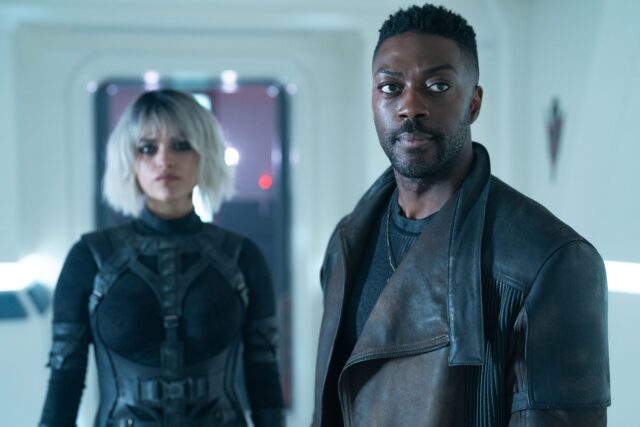
Okay, let’s just agree we both have daddy issues.
Under the mask
The reveal that L’ak is a Breen was a surprise, but also nicely teased through the previous episodes. Fans of Deep Space Nine should relish finally getting some answers about this enigmatic race and finally having a first look under those helmets. “Mirrors” picked up on many elements from DS9, including the Breen language, refrigeration suits, neural truncheons, and the position of Thot , while adding lots to the lore, including some worldbuilding behind this new Breen Imperium and its “faction wars.”
Setting the Breen up as what appears to be the real big bads for the season involved a lot of data dump exposition here, surely keeping the editors of Memory Alpha busy for the next week. The notion that Breen have two forms with their signature suits and helmets allowing them to hold the more “evolved” form and face makes sense. If one were to get nitpicky, the Breen aren’t supposed to bleed, but perhaps that was a function of his suit; fill in your own headcanon. L’ak’s desire to hold the other, less evolved form making him a pariah in Breen society has echoes of allegorical episodes such as TNG’s “The Outcast.” That being said, the nuances are still not entirely clear, and fans who like the lore shouldn’t have to rewatch scenes to pick up the details. It feels like some details were cut, perhaps because this episode was already trying to cram in too much exposition with the Breen, Kelleruns (they boil cakes?), and the Mirror Universe.
Like the previous time travel adventure, this was a mid-season bottle show, this time using the conveniently located Strange New Worlds sets. Bringing back the ISS Enterprise was clever and fun, with the twist of how this time the Mirror Universe came to us. If you follow closely, “Mirrors” did a nice job of filling in some lore gaps and tying together the MU storylines from the first visit in “Mirror, Mirror” to follow-ups in Deep Space Nine , Enterprise , and Discovery . There is now a nice throughline from Emperor Georgiou saving Mirror Saru through to Mirror Spock, killed for the reforms he instituted after being inspired by Kirk. However, the redress of the Enterprise sets was not very inspired, with only a smattering of Terran wall sconces and some repainting, instead of demonstrating the brutality of the Empire with elements like agony booths. But what was even more missed was the promise of any character crossovers. There was a lot of talk about Mirror characters like Spock, Saru, Dr. Cho, and others, but we don’t get to see any, one of the many examples of how this episode broke the golden rule to show not tell. There were plenty of opportunities for a flashback or holo recording. Burnham longingly gazing at her brother’s science station is no substitute for Ethan Peck with a goatee.
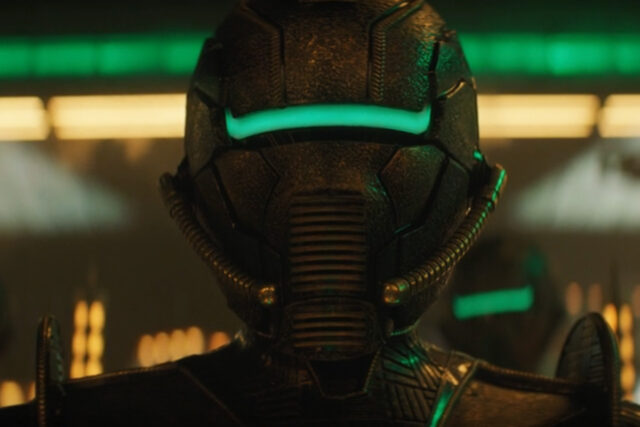
We’re back!
Final thoughts
“Mirrors” is a decent episode, but it could have been much better with a few tweaks here and there. While not falling into the pointless plate-spinning trap of past mid-season Disco outings, it still dragged a bit for something so jam-packed with lore and revelations. Still, it provided a nice hour of entertainment, and possibly more with rewatches to catch up on the little details. The episode also continues the season’s welcome trend of weaving in the show’s own past, which makes it work better as a final season, even if they didn’t know that when they crafted it. Season 5 hits the halfway mark, and it’s still the best season yet, and hopefully the second half of the season will nail the landing.
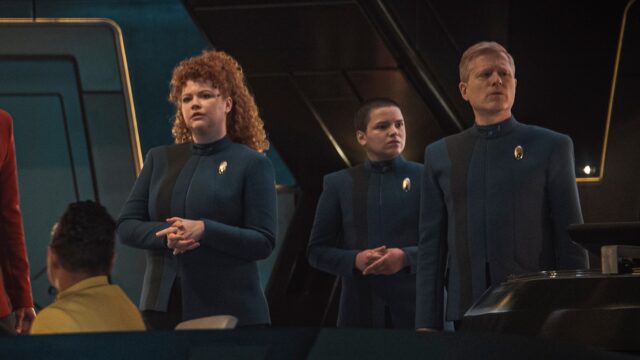
Wait, we’re in this episode too? Anyone remember their lines?
- Like the previous episode, “Mirrors” began with a warning for flashing images.
- The episode is dedicated “to the loving memory of our friend Allan ‘Red’ Marceta ,” the lead set dresser who died in a motorcycle accident in 2022. Presumably the USS Discovery bar “Red’s” was named in his honor.
- This is the first episode where Book’s personal log starts it off.
- Stardate: 866280.9
- Booker examined wanted notices for Moll from the Federation, Orion/Emerald Chain (who have a new logo), and the Andorian Empire.
- Tilly was able to reveal the wormhole by compensating for the “Lorentzian Coefficient,” referencing the real Lorentz Factor used in special relativity equations.
- A new ensign on the Discovery keeps a Cardassian vole as a pet.
- The ISS Enterprise was built at Tartarus Base, possibly referencing Tartarus Prime , from the TOS novel The Rings of Time .
- Moll refers to Breens as “bucketheads” (just as Reno did to Emerald Chain Regulators last episode). This could be a nod to the use of “ bucketheads ” in Star Wars as a derogatory term for stormtroopers.
- Moll’s mother died on Callor V in a mine for Rubindium , a substance first mentioned in TOS “Patterns of Force.”
- Linus can play the piano.
- Breen Primarchs may be a nod to the genetically engineered Primarchs from Warhammer 40,000 .
- How does Book know that Pike’s catchphrase is “Hit it”?
- This is the third (of five) season 5 episodes in which Oyin Oladejo and Emily Coutts do not appear, but their characters, Detmer and Owosekun, are mentioned when they get the honor of escorting the ISS Enterprise back to Starfleet HQ.
- Even though we didn’t see it warp away, presumably the missing intermix chamber was replaced, otherwise Owo and Detmer’s trip is going to take a very long time.
- Tilly says her long day makes her feel like she has been through a Gormangander’s digestive tract.
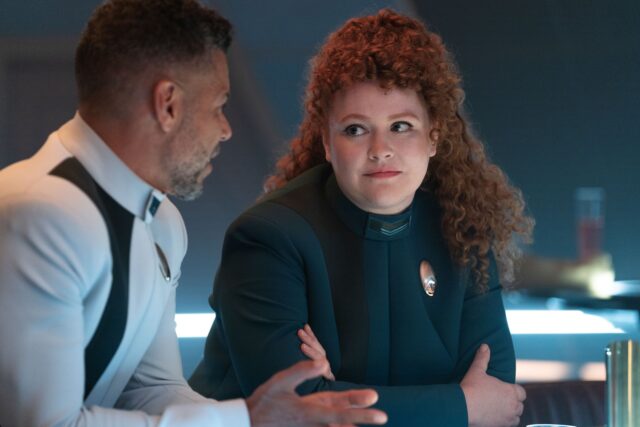
Remember when Mudd hid inside a Gormagander? Gross.
More to come
Every Friday, the TrekMovie.com All Access Star Trek Podcast covers the latest news in the Star Trek Universe and discusses the latest episode. The podcast is available on Apple Podcasts , Spotify , Pocket Casts , Stitcher and is part of the TrekMovie Podcast Network.
The fifth and final season of Discovery debuted with two episodes on Thursday, April 4 exclusively on Paramount+ in the U.S., the UK, Switzerland, South Korea, Latin America, Germany, France, Italy, Australia, and Austria. Discovery will also premiere on April 4 on Paramount+ in Canada and will be broadcast on Bell Media’s CTV Sci-Fi Channel in Canada. The rest of the 10-episode final season will be available to stream weekly on Thursdays. Season 5 debuts on SkyShowtime in select European countries on April 5.
Keep up with news about the Star Trek Universe at TrekMovie.com .
Related Articles
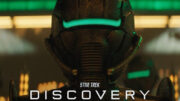
Discovery , Interview
Interview: ‘Star Trek: Discovery’ Writer Carlos Cisco On Unmasking The Breen And Revisiting The ISS Enterprise
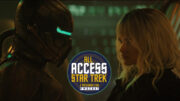
All Access Star Trek Podcast , Discovery , Strange New Worlds
Podcast: All Access Gets To Know The Breen In ‘Star Trek: Discovery’ 505, “Mirrors”

Books , Discovery
Coffee Table Book On The ‘Star Trek: Discovery’ Makeup Artistry Of Glenn Hetrick Coming In September
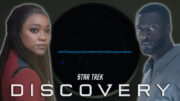
Analysis , Discovery
THEORY: Did ‘Star Trek: Discovery’ Finally Resolve The “Calypso” Mystery?
waste of ISS Enterprise
While I enjoyed the episode overall, the ISS Enterprise was a huge letdown and not even worth being an easter egg with what little they did with it. They should have just made it a generic constitution class ship from the mirror universe.
It felt like it was nothing more than a budget saver. Use existing sets from the other show. Which is weird because one of the arguments in favor of mini seasons is it allows more money to be spent.
That’s exactly what it felt like. Along with the missing, yet again, Detmer and Owosekun.
There must have been some deep budget cuts for the season.
Detmer and Owosekun were replaced by other characters so I don’t think they are missing for budget reasons. It’s more likely that the actresses were unavailable.
I get the budget issues considering what’s going on with the studio. But the end result was it showed that there isn’t much difference at all in the 900 years between the SNW Enterprise and the aesthetic of Star Trek Discovery. They both look as if they were set in the exact same era.
And there really shouldn’t be much. Discovery is from the same era, as the Enterprise. While the ship gets a technological upgrade, why would it get an interior design makeover?
Since it was deemed important (Stamets certainly makes since) that the crew stay on the Discovery, I would certainly think that psychologically having its design aesthetics stay similar to what it was would help give the crew a little bit of their past to hold on to, versus having all physical interactions be with a timeline that they aren’t native to.
Now where we should see it is in native places in this time. And we have seen some differences in design from standard Starfleet settings, versus Starfleet settings on this time (I actually wish we got more).
I did wish for a little more of self reflection from Burnham’s point of view as the ISS Enterprise should of course remind her of Spock (the Enterprise tie in), but also Georgiou (the ISS tie in). We get a small brief nod to Spock, but nothing to Georgiou (and while I still question the use of the character, there is no question that Burnham did have a connection with her, even if its primarily transference from her former Captain, not the mirror Universe Empress.
It’s not just the ship. It’s everything. Everything else looks like it matches the ship’s aesthetic. As if 900 year old retro is the current fad in design.
That’s always been my issue with Discovery.
To me that is part of the downfall of going so very far into the future. What aesthetic you make should be radically different. Not just shinier.
Agreed. The last two episodes just felt very budgeted and basically bottle episodes. And this just felt like a twofer, a way to use an existing set and add a little fan service but that’s all it was. I thought the Enterprise itself was going to be a viral part of not just the episode but the story overall.
Instead it was just a backdrop. And yeah it’s obvious they cut the budget for this season but all the live action shows have felt this way starting with Picard season 3 and SNW season 2. That all felt pretty bare a lot of the times. I guess this was all during Paramount+ belt tightening and probably not a shock why the show was cancelled.
And maybe the I.S.S. Enterprise should have been the refit or maybe the Phase II Enterprise? That would have been a lot of fun but combine a lack of vision with a reduced budget and this is what you get.
Looking back on “In a Mirror: Darkly”, season 4 of Enterprise was dealing with a reduced budget but managed to recreate sets from TOS, introduced a few new set pieces and did a lot of great effects work.
This was a missed opportunity.
Which was added by stretching that story over two episodes, so that they had the budget to recreate the sets they used. Having half the episode count, doesn’t really help avail yourself to planning out a two parter for a way to save costs.
If Picard could pull off recreating the bridge of the Enterprise D for three days of shooting with barely half the budget of Discovery season 5, they could have done something equally as fun for Discovery on the cheap without actually having to building anything new and using the Enterprise as a crutch. They could have come across Deep Space Station K-7, where the exterior would have been immediately familiar and with interiors served by redressed sets from virtually anything available from Discovery or SNW.
I thought Discovery is basically the PII Enterprise?
The Phase II Enterprise looks like a slickly modified version of the Enterprise from TOS, falling squarely between the Enterprise from TOS and the refit. The “Star Trek: Phase II” fan series did a great job bringing it to screen.
No, Discovery resembles the Enterprise concept for the Planet of the Titans movie.
I don’t get that. I never assumed that the Enterprise (or its mIrror Universe history) was going to feature in significant manner (certainly the producers and promotional department didn’t make a significant deal about it). Perhaps it’s the time difference. But I literally assumed it would be as significant as the Defiant going in and out of phase like TOS “Tholian Web” the time difference. And that was primarily set dressing. That’s not a bad thing. I mean Tholian Web is considered one of the better third season episodes.
And the only reason I assumed it was the Enterprise versus another Connie, is simple to give Burnham a moment to reflect on Spock. Now I do freely admit that I wish this was a slightly larger moment. But I never expected it to be anything but a small moment. Roughly my preconceived notion would be something like Spock’s Mind Meld scene with La’an in SNW where she is able to get a peak into Spock thinking about his sister and the emotion that comes with it. It’s a very brief scene, but I thought SNW did a good job in conveying the emotional aspect, especially from a half Vulcan/ Half Human.
Ok fair enough. This is probably more my hang up and to be fair since they never really promoted the the Enterprise being back then clearly they weren’t trying to make it that big of a deal.
But same time a lot of people do feel there could’ve been more done. The main problem is it just feels like a ridiculous stretch this ship itself is even there. It’s a ship from 900 years ago from a DIFFERENT UNIVERSE that conveniently happens to be the ship that gives them their next clue. I know it’s Star Trek so whatever lol. But when you go through the effort to present it I think it would’ve nice to build a bigger story around it. It could’ve just been any ship.
Exactly! The ship could have been any ship. The fact that with such an enormous universe(s) they would happen to find the next clue on a Mirror Universe ship and the ISS Enterprise no less–it’s such “Small Universe Syndrome”.
When you feel like the Mirror Universe has been nothing but a let down after the initial TOS episode, It’s really not a surprise. There’s really nowhere to go with it, but I did find that the fulfilling of the promise that Prime Kirk spoke to Mirror Spock about from the original TOS episode quite satisfying. The ship’s inhabitants embraced the benevolence of the prime universe, and I thought that was great.
I felt the idea that the MU people just easily adapted was pretty ridiculous. But then, they admitted SNW was an alternate timeline. It’s not a stretch that alternate extends to all the Secret Hideout productions.
I’m not sure I would feel the same about Picard given it depicts the Prime events of ST:2009. The others tho yeah I think of it that way too. Although The Chase does make that harder to swallow about DISCO
I liked the MU in DS9. It was fun to revisit and a great reminder of the Prime Directive. But… after that it got tiresome.
It was pretty benign there, but the problem with it, is finding it plausible. It was a fun idea in the 1960’s, and it had a good message. After that, it an indulgence. The notion that that the same people would even exist in the same fundamental places, and that the same ships would exist with virtually the same crew just seems like too much of a stretch even for modern Star Trek.
That’s my only complaint about this episode. Seeing the tantalus field show up would have been really cool. When Michael talked about how she was sure that Mirror Spock was a savage just like the other Terrans, I was sure that we would see a recording or something of Ethan Peck in a goatee to prove her wrong. Or flashbacks with Ethan Peck and Paul Wesley as their mirror counterparts would have also been cool.
All the stuff with the Breen and Mol and Lak was really cool though.
“ waste of ISS Enterprise” should be the official episode description.
waste of series
They ate Mirror Saru in season one…
Was that Saru or another Kelpian? It’s been a while since I watched Season 1, but I recall Mirror Saru saving Burnham from Tyler just as Voq’s personality re-emerged. I know Mirror Georgiou served Burnham some Kelpian, I just didn’t remember it being Mirror Saru.
Mirror Saru saved Michael from Tyler in The Wolf Inside, which was the episode that preceded the one in which they ate the food made from a Kelpien (Vaulting Ambition).
Looking at Memory Alpha now, it says that the chosen Kelpien ( https://www.youtube.com/watch?v=aVQSipQlJR8 ) was played by someone other than Doug Jones, but they look so much alike that I thought for sure she had chosen Mirror Saru.
As per Memory Alpha, we never saw him again after The Wolf Inside until season three, but that was in the alternate timeline Carl sent Georgiu to, so it wasn’t the same Mirror Saru.
Nope, that was another Kelpien.
“They ate Mirror Saru in season one…”
They didn’t.
Wasn’t Mirror Saru established as having survived in Season 3 (can’t remember the episode name).
A s per Memory Alpha, we never saw Mirror Saru again after The Wolf Inside until season three, but that was in the alternate timeline Carl sent Georgiu to, so it wasn’t the same Mirror Saru.
Loved this episode. I liked seeing the I.S.S Enterprise though i would of loved to of seen maybe a video log of Mirror Spock.
As a big fan of DS9 I’m glad we finally get to see what a breen looks like and the 32nd century breen outfits look great.
I enjoyed seeing Book/Burnham trying to get through to Moll/L’ak and i hope they can eventually get through to them. With this season about connections and 2nd chances i can see Book and Burnham talking both of them down before they do something that they can’t come back from.
The shot of the I.S.S Enterprise coming out of the ‘wormhole’ is probably one of my favorite CGI scene in all of Trek.
I’m glad they didn’t. I think the conceit of using the I.S.S. Enterprise was not much more than a budgetary decision to be able to use the sets. Could have made it a different constitution class, but then they don’t get to tell the story of the crew’s transformation into our society. Just don’t think about it too much.. because that universe is just pushing out its own doppelgängers into our universe.. which seems problematic. lol.
As a big fan of DS9 I’m glad we finally get to see what a breen looks like and the 32nd century breen outfits look great.
Any kind of big reveal was bound to be disappointing, I suppose. Still, the idea that they were just another latex alien was a letdown. I had always hoped that the Breen were gaseous or plasma creatures.
Ethan Peck with a goatee would have been EPIC
“This is the way.” 😉
But seriously that was a pretty good episode. I’d like to see a 31st century restored Terran empire that never went through “the burn.”
“ The reveal that L’ak is a Breen was a surprise ”
It really wasn’t, though. That was many viewers’ guess since the beginning of the season, and it’s been a common discussion on many websites. The surprise would have been if he HADN’T been a Breen.
I am on a lot of other sites and I haven’t heard anyone thinking he was Breen. And I don’t believe anyone voiced that in Trekmovie either.
LOL. It’s been a common theory.
Obviously not THAT common. LOL
I’ve seen the theory mentioned in the comments here on TrekMovie.
Yes, quite common from what I’ve been reading. I just commented on this very site a couple weeks back that I liked the idea, when somebody else theorized it (forget who it was)!
I guess it’s just where you go for these discussions but yeah the first YouTube review of episode one I saw theorized Lak was a Breen in the first scene he was in when he took off his helmet. And this was obviously before the species was mentioned on the show.
So yeah some people caught on the first episode the way others theorized Tyler was Voq the first time he showed up. Others needed more convincing.
I never saw it but I certainly don’t read the majority of comments. And almost never watch video reviews. Now Voq, was something I remember seeing in many places. Though in fairness, the amount of conjecture done about any Trek series for its Pilot and early couple episodes has been in my experience far more than what you see for most regular episodes. So that shouldn’t;t surprise me.
It was a surprise to me.
The Breen being so ordinary looking was a bit of a surprise.
Well, one of their forms are. It explains the frozen wasteland/tropical paradise. Their “evovled” form needs cryo suits, their “normal form” doesn’t
Was a surprise to me. Then again, I don’t run around the internet and over analyze the show.
This season started out so well. What happened? It’s falling apart.
I hate to a agree. But its once again a long slow burn (pardon the bun) that I fear is going to lead to another whimper of a conclusion. I feel like the season could have been a movie instead. Where is Chapel?!
Wrong show. Chapel is on SNW. The ending was rewritten and new scenes were shot to make it a series finale. They had already started shooting when they got the word that it was ending after season 5.
presumably on Her show, SNW?
“pardon the bun” …🍔⁉️
What’d that poor bun do for it to be in need of a pardon? 😋
This is what happens in every single season of Discovery. Two lovers who want to destroy the galaxy so they can get to paradise was the plot of season four, and now they are recycling the exact same plot for this season.
Did you watch the show. In no seasons has two lovers wanted to destroy the galaxy….Period. L’ak and Moll want to pay off their bounty. Nothing about what they are doing is about wanting to destroy the galaxy.
Outside of the destruction caused by the aliens referred to as 10-C, did any character want to destroy the galaxy let alone a couple. The only couple we had, was one person wanting peaceful means of communication to prevent destruction, while the other wanted to use force to ensure the destruction doesn’t occur. In no case does that equal people wanting to destroy a galaxy.
I can understand not liking the show, but to have such a misconstrued concept of the plot of the seasons shows a shocking lack of basic understanding of what the plot and motivations of the characters are.
I mean the show has plenty that one can find legitimate issues with. Thats not one of them.
They want to pay their bounty by giving a weapon of potential mass destruction to the Breen, thus destroying the galaxy, as seen in the time jumps last episode. They want to do that so they can escape to the Gamma Quadrant while the Breen take apart the Alpha Quadrant.
Last season the scientist wanted to let the 10-C species bulldoze the Alpha Quadrant so he could get across the galactic barrier to meet his lover in paradise, without caring what happened to trillions of other lives.
It is the same basic plot point. Your analysis is incorrect, Wood.
I think you’re overreacting a little. As always.
This episode was disappointing and fell flat. The return of the ISS Enterprise from the mirror universe was of no interest. I had hoped to possibility see a video log from Kirk, Spock, or another familiar character. Why not explore other Constitution Class Starships like the ISS Lexington, Hood, or Potemkin? Enterprise, Enterprise, Enterprise. (Sigh)
Maybe cause the enterprise is the trek ship pretty much everyone knows even if they are a new trek fan or a casual trek fan or not even a trek fan it is so engrained and intertwined with the name Star Trek that is why they chose to make it the iss enterprise instead of one of the others you mentioned
Because exploring a random ship isn’t the plot of the episode. It’s basically set dressing. Having it be the Enterprise versus a different Connie, gives it a tie to the lead character and part of her family she left behind. That it sorry wise. Another ship wouldn’t have any emotion aspect to the characters. Now production wise its to save a ton of money, as creating a random ship with multiple settings to take use of takes money (if your trying to give it the same level of production that you see for the primary ship). Now of course they could have just created a redress of an existing set to be random alien ship of the week. Those usually aren’t done to the same level of using the existing bridge set of another show. So it serves a small story purpose (ie a setting), it serves a small character purpose *reflection for Burnham, and it serves a production purpose (having high quality set pieces without having to build or do a serious redress and thus saving some money).
Seems rather obvious, to me.
I’m annoyed by what they seem to be doing with Owosekun and Detmer this season. I assume that the actors are absent because Paramount wanted to pay them less, and that’s poor treatment for characters who have been around since practically the beginning of the series.
“ I’m annoyed by what they seem to be doing with Owosekun and Detmer this season. ”
…as opposed to the previous four seasons, when all they did was sit in chairs and look meaningfully at each other?
Which is all Sulu and Chekov do in the average TOS episode. So yes, it’s aggravating for them to be replaced by other actors who are doing the same thing.
I doubt they are paid exorbitantly as recurring guests. It could be similar to what happened in season 4 and Bryce Ronnie Rowe Jr’s absences – he had another gig.
I have a theory that before it was decided that Disco would be cancelled, they were going to replace some of the characters. I think Owosekun and Detmer were going to be replaced, and also that Rayner would become captain and Burnham would go away to do something else. But then that didn’t work out, and so to us it just makes no sense why those two main characters are suddenly missing.
You might be right — I hadn’t considered that revamps due to cancellation might be involved.
Well… It is what it is . This was easily the worst episode of the 5. Tropes galore and really bad plot contrivances.
It feels like the reshoots for when they got the cancelation news are getting dropped in throughout the season. A lot of scenes appear grossly out of place. It feels like they just aren’t even trying anymore to be honest. As flawed as the show has been one thing that never came across among the other problems was a lack of trying.
I am loving the addition of Rayner and the professional Starfleet officer energy he is bringing to the ship. I also liked when he told Burnham the mission was too dangerous for the captain to go on. He is turning out to be a nice counterbalance to the unusual way Discovery has been run as a Starfleet ship after season 2.
I hope he doesn’t get killed off.
Sorry but this was another big fat ‘meh’ for me. This was very very disappointing. Nothing of consequence happened. We learn Mol and Lak backstory basically and it is cool we learn that Lak is a Breen which has been the leading theory since he showed up but it just felt sooo bare overall. Like another Discovery infamous spinning wheel episode where they do the bare minimum to move the plot along but just through a lot of action scenes and inconsequential dialogue to feel like we were getting any real development.
And the biggest elephant in the room (or dimensional wormhole) was the ISS Enterprise. Such a let down. It almost felt like a gimmick or just shoehorned fan service. There was no real reason it needed to be there other than HEY THE ENTERPRISE IS BACK!
Again one of the problems with this show, no real development just there for another connection. Think about what they did with In a Mirror Darkly on Enterprise. They brought in the Defiant as obvious fan service from TOS but the ship had a very vital part to the story. It helped changed the dynamics of the MU. It wasn’t there just for show like this was. And Anthony made a great point the redress felt like a joke. It just felt like an excuse to use the set but little else.
Here it was nothing more than just a backdrop and a really forced one at that. And the whole Saru thing just felt very contrived.
I did like all the Breen stuff though and hopefully they will be the big bad the rest of the season. I still think they should’ve used the Breen as the main villain for SNW instead of the Gorn but I digress.
But yeah this is probably the weakest one for me which is disappointing since last week is my favorite so far. I’m getting a little nervous now. It’s usually the second half of the season this show begins to falls apart but still open minded. Still enjoying it overall but please don’t end up a tedious bore like last season felt once it got to its mid season.
You have one last chance Discovery, make it count!
I never considered the Breen in SNW before, but that’s a cool idea. Yeah, I would’ve liked that much more than the Gorn.
For me it was literally the first Gorn episode I thought the Breen would’ve been a better idea. You get the same type of stories and it doesn’t feel like it’s breaking any canon like the Gorn obviously does. I ranted enough about it but nothing about their appearance on SNW feels remotely canon anymore.
But the Breen could’ve been a great substitute if they wanted a known species not named Klingons and zero canon issues.
Agreed. I always enjoyed the mysterious quality of the Breen. Seems ripe for exploration.
This season is largely working for me. Not as good as last week, but the chase is enjoyable. I have a little trouble buying that Mol and L’ak fell in love so fast. I would have liked to have seen that handled better.. but the slow burn of the plot works because of what they do to sustain individual episodes. Only episode I thought was kind of wasteful was the one on Trill.
That is a big part of the problem, yes. The characters have little chemistry.
The flashbacks took [place over an extended period of time, it wasnt THAT fast
They both felt like outcasts in their family/society, fusing them together like lightning. I had no problem with that as it gave me a Bonnie & Clyde-vibe which is historical.
It’s fine, but the romance piece just isn’t clicking for me.
Tarka was a similar situation last season with the reveal of his motivation not really moving me, but I’m also not the biggest fan of waiting several episodes to fill in a lot of backstory in a flashback. It’s not easy to pull off, and Discovery hasn’t really perfected it.
It’s a wonder I stuck with Lost as long as I did, now that I think about it.
“ it’s still the best season yet ”
Well, it was for the first two episodes, but the three since then have been a downward spiral. Seasons one and two were much better than this week’s episode and last week’s.
I’ve enjoyed it all except for the Trill episode. I think it’s been fun with a faster pace.. which has helped with a lot of issues that haven’t gone away. Raynor has been a very welcome addition to the cast.
Overall, very entertaining!
For complaints: any other constitution ship would be cool – but I also feel like we don’t know what happens next – there could be some Prime Mirror Universe people out there. & the “hit it!” joke felt like Dad was in the writer’s room.
Otherwise, I the pairings felt very TOS. Rayner is a little bit Serious Scotty when performing a captain’s role. And he took pride in rescuing her – which is feels good.
For me, this season has been 5/5.
Personal Log. Stardate: Today.
Week 4 of not-watching Discovery continues without incident. Opinions gleaned from critics on the latest episode seem to confirm that ‘mid-season malaise’ has been reached right on schedule.
Based on the collective opinion of commentators, there have been a grand total of one episode out of five that qualifies as “actually good”.
In conclusion, it appears the decision to not-watch until the penultimate episode has been vindicated. The plot points I am privy to following the one episode I watched are:
– There is a chase (or ‘The Chase 2.0’) for the Holy Grail / the technological marvel Salmone Jens left behind.
– The Cylon is now the First Officer.
– The Trill and the Robot are no longer together.
All in all, I remain confident that the recap at the beginning of the penultimate episode should be sufficient to fill in all the key points required.
Again, my thanks go out to the resolute souls who manage to endure what I could not.
these threads are for people to talk about the episodes they have seen. CLOSED.
Am I wrong or did the DS9 episode Through the Looking Glass make a reference to the Mirror Spock being on Romulus? Also given all the DS9 cross overs with the Mirror Universe you would think Burnham would have known something more about her brother’s counterpart.
Spock was not mentioned in Through the Looking Glass. We know between Crossover and the new dedication plaque of the ISS Enterprise that he reformed the Terran Empire and was killed for it. Burnham has clearly boned up on a lot of info since coming to this century, but easy to assume the future history of the mirror universe wasn’t part of that. Also, that info could have been lost or been classified.
Wow! The Breen. From CGI to burn victim.
Does anybody think the Commander Rainer is gonna become the Commandant of Starfleet Academy?
Everything involving Book is incredibly tedious. They brought back the ISS Enterprise as a way to resurrect the OG Enterprise in continuity. Perhaps it ends up as the Enterprise Q or whatever, if Saru is in command then ok. Burnham insisting on going on the away mission is diametrically opposed to how TNG dealt with this – e.g., when Riker as captain insisted on boarding the Borg cube in Best of Both Worlds, and his senior officers reminded him his place was on the bridge. I guess everyone got much dumber in the 32nd century, but “dumber” is Discovery’s whole concept.
This post missed an important Easter egg towards the end: Morn was at the bar “Red’s” just like he did on Quark’s on DS9.
We don’t call out or find every little egg, but when the bar was introduced last season we noted the Lurian (Morn’s species), who has been there ever since. We don’t usually do repeated easter egg bits for each episode
Yay! Good seeing the Breen again and their evolved design in the 32nd Century is great.
Boo! Pretty much everything else except Rayner who is the best character in the show.
Imagine they used the Star Trek: Tour set in Trekonderoga for the ISS Enterprise? What a cool surprise that would have been. But nope, we got the generic canon-breaking Discoprise. Not surprised.
I swear if they make the new Enterprise in the 3190s a refitted Constitution, I will facepalm. Just a stupid idea, when you have far superior tech and designs in the future time period. Please don’t, Disco-writers. Bad enough they did it with the Ent-G (one of my few criticisms of the great PIC S3).
here are 6 points for a reply to each of your issues with snw and dsc as a whole and this episode in particular
1.there is already a constitution class in the 32nd century it’s design was also used pre burn in the late 31st century so i dought they would refit iss enterprise like they did with the discovery plus they did say the ship was being taken to a federation storage facility
2.as for why they used the snw sets and cg assets well two reasons for one location/budget convenience as snw is shot in toronto at the same studio as dsc is and two they have said from the start they visually updated the 23rd century to fit visually better between ent era and tmp era mainly star trek 5/6
3.and there is nothing canon breaking about any of the new shows as they give explanations that tie back to enteprise and first contact since enterprise tied into that movie for the reasons of in unverse changes to the prime timeline universe and that is time travel to fix the past either on it’s own or part of the temporal cold war
4.and the temporal Cold War which later turned into the temporal wars is the reason the discovery was refited and givin the -A at the end of the registry is to hide the fact the ship and crew time traveled and broke the law agaisnt any form of time travel that was put into place after the temporal wars and a smaller part to protect starfleets butt
5.and if you have to don’t look at seasons 1 and 2 of dsc and snw as prequels to tos but as sequels to ent and then veiw ent as a sequal to first contact as i hear it makes it easier for some tos fans to enjoy these trek shows
6.or use the in universe reasons for the changes mentioned above in point 3 to be able to enjoy watching new trek shows mentioned above in point 5
Would it have been too much if Dr. Cho was instead Marlena Moreau? Just saying. Kind of like Dax in Jinaal… I feel like they are making all of these deep cuts, why not make them count a bit more to the overall lore, instead of just throwing the ISS Enterprise in with no good reason. Making these deep cuts actually count towards the overall lore might make the obvious (potential) budget cuts, set reuses, etc. be a bit more forgiving. Giving loved characters some finality that affect the course of this in our face galactic scale quest… might make it hit harder? Maybe I’m wrong, I’m sure someone here will think so lol
Overall the episode was okay. I do understand using the ISS Enterprise since this is supposed to be the final season of Discovery it was a nostalgia play and kind of wrap up the history of that ship in regards to the series. But overall it just seems kind of mashed together. Have to see how it ties in with the rest of the season.
I would say this episode along with the one before it were definitely the weakest of the season. They started out with a bang on the first few, and while I know that they tend to slow down in the middle of the season before ramping up the action for the final few, this episode dragged. There were also a few things with the Breen and the Enterprise that seemed a bit confusing:
– The Breen have 2 faces…great! Awesome twist to the species and fantastic to finally be able to see them after all the mystery around them in DS9. If the second face is supposed to be the more evolved one though, why do they need the masks and the suits? Can the more evolved face not breathe in a standard atmosphere? When L’ak and his uncle opened up their masks, they seemed fine, so there’s still quite a bit we don’t know about why they use that whole setup, especially when they’re around their own people
– Does the more evolved form extend past the face?
ISS Enterprise
– The stardate on the commemorative plaque is 32336.6. Popping that number into a couple of online stardate calculators puts that around mid-2355, which would be a few years before the prime universe Enterprise-D was commissioned in 2363. They mentioned that Dr. Cho came back to the Enterprise to hide the clue, so the assumption is that she also placed the plaque there at the same time. The timing doesn’t quite add up though because The Chase took place in 2369. Nobody would have known about The Progenitors or their technology before that, so they were at least 14 years off with the plaque
– If this Enterprise has been caught in extradimensional space since at least 2355, that means it’s been there for over 800 years by the time it’s discovered. How does it still have power?
– It’s been discussed by the Disco production team that the Discovery-era Enterprise was designed so that it could eventually be refit into the TOS Enterprise. The ISS Enterprise was contemporary with Kirk’s version and was seen on screen in TOS in that configuration. Why is the version in this episode the Discovery one? I know the real-world explanation is that it was easier to just re-use that model to align with the sets, but we saw a TOS-era Constitution class USS New Jersey at the Fleet Museum in Picard, so they had that model available to use. Just a bit sloppy
– How did Stamets immediately know that the ship exiting the wormhole was the ISS Enterprise and not a different prime Constitution class ship?
Photon Torpedo
– The solution to hold the wormhole open for the Enterprise to escape was to remove the payload from the torpedoes and replace them with antimatter. Photon torpedoes are matter/antimatter weapons, so this is a little confusing. Are they taking out the matter and just loading them with more antimatter?
I don’t know that it’s been there for 855 years.. not sure if it’s kind of like the Nexus or the black hole in Trek 09, where time does things differently. My guess is, that’s how the people on board were able to integrate into society. Their doppelgängers were long deceased.
Here’s the other thing… if the idea of revolution started with Mirror Spock, and the crew of the Enterprise more or less went along with him.. this is a way of explaining how they didn’t spread the idea to teh rest of the Empire.. they were lost in space and didn’t have much, if any, influence off of their own ship.
But they did spread the idea enough to weaken the empire to the point where it could be conquered.
Yeah I was wondering that also. It’s possible since it was extradimensional space that it didn’t put them in exactly the same time that they left. Also odd that they said Dr. Cho went BACK to the Enterprise to hide the clue. That’s a pretty risky trip unless the wormhole was more stable back in the 24th century.
It is strongly implied, if not explicitly stated, that the wormhole’s instability was caused by the Burn. So, it had to be more stable in the 24th century.
they never said that the ship would be refited into the tos version as they said those 60’s sets and ship model design would not look good or belivable as from our future with modern filming cameras they said from the start they visually updated the mid 23rd century to fit better visually between ent era designs and tmp era designs mainly using Star Trek 5/6 as the basis for the tmp era side of the designs
as for the new jersey that was just a pandering memberberry easter egg for the fans that hate the visual updates and even blass has said he objected to using the 60’s design for the ship and pointed out that it should have used the snw model for it and that it was all on terry who was more interested in filling episodes with those easter eggs and memberberries like all the stuff on daystrom station and for having data come back instead of having a brand new soong type android that was exactly as alton soong designed it to be a amalgamation of data lore lal and himself
I feel like I’m seeing the same episode over and over, what a waste this series is became.
Great episode! This season has really been fantastic so far. The writing has been consistent, the acting of the principals is fantastic, and the pacing has been great.
I really loved the scenes with Rayner in command. That worked so well!
Loved getting the backstory about Moll and L’ak – it really did add layers to their characters and their story. And the reveal that L’ak was a Breen! I never saw that coming! Was great to know more about the most underdeveloped and mysterious alien race in Trek history.
Seeing the ISS Entreprise was a treat! I am guessing it was lost quite some time after mirror Spock took over from mirror Kirk. Nice Easter Egg… better than having some unknown ship in there.
Looking forward to the remaining episodes.
Did anyone else see “Morn” (or one of his species) sitting at the bar in Red’s?
Yes, I did catch that. It was a fun detail.
Seriously, an episode doesn’t go by without at least one eye roll over the touchy feely huggy share my feeling vibe that is shoe-horned into worst places. I wonder what this series would be like if Bryan Fuller had stayed on…
It would had been .. a Star Trek show, not this happy sad feeling sharing at all costs every single time somebody speaks.
I have a question because I’m really confused:
So discovery originally was set less than a decade before ToS. (And then they ended up far in the future)
The ISS enterprise is a reference to the ToS episode about the mirror universe. So that means the ISS enterprise is a contemporary with ToS and the USS enterprise, which means Dr Cho (who was expressly stated to be Terran) was about back in Kirk’s day.
However the progenitor technology and science in general was only discovered in TNG under Picard and i think it was expressly stated that the scientists that hid this research were originally asked to research it after the discovery by Picard in the first place.
TNG is set in the 24th century but ToS is set in the 23rd century – theirs about a hundred years between them.
So I’m trying to understand the timeline here because at the moment, from what I understand, it’s a human from the 23rd century somehow became a scientist on a study in the late 24th century and then stole the research and helped hide it with her 4 pals.
No the iss enterprise entered that anomaly in the mid 24th century sometime after 2355 going by the stardate on that plaque and the ship got unstuck in time via the anomaly and the refugees and survivors of mirror Saru’s revolt ended up in the late 31st century prime verse timeline sometime prior to the burn happening and then doctor Cho who was one of those survivors returned later to the ship to hide the clue there before leaving again and never returning and wiping all references to the ship from records so that it would not easily be found
I thought for sure the Real Captain Lorca would be found in the transporters.
What a waste of an episode… filler and feelings…. Rinse and repeat
What an empty, disappointing episode. Discovery feels smaller and smaller every season.
- The Original Series
- The Animated Series
- The Next Generation
- Deep Space Nine
- Strange New Worlds
- Lower Decks
- Star Trek Movies
- TrekCore on Twitter
- TrekCore on Facebook

Commander Rayner (Callum Keith Rennie) isn’t thrilled by this prospect, pointing out before she leaves that it’s too dangerous a mission for a captain to undertake. But Burnham disagrees that this is enough of a reason to stop her; it’s a nice reminder that this is a show and a character that originated in the time of James T. Kirk, a time when captains didn’t stay behind in the face of danger.
But it’s not only that, there’s something else going on. Burnham gives Rayner permission to be blunt, quoting a classic work on Rayner’s native Kellerun , The Ballad of Krull , asking him to “serve it without a crumb of ossekat .” (As far as made-up Star Trek idioms go, that’s a pretty good one.)
It’s also the beginning of a sudden and relentless onslaught of references to Rayner’s culture, but more on that later. What’s Rayner’s problem? He’s uncomfortable with the prospect of being left in command of a ship and crew that aren’t “his.” Welcome to being second in command, buddy.
Book and Burnham take off, heading into the wormhole and finding it to be an inhospitable place. They quickly drop out of communication range with Discovery , there’s ship debris everywhere, including the wreckage of Moll and L’ak’s ship…. and what’s that, the ISS Enterprise ?!
(A side note before we get too excited about that: what is the deal with all the empty space in the new shuttlecraft set, introduced in last season’s “All Is Possible”? The two pilot seats looked like they were crammed into the corner of a huge unfurnished room.)
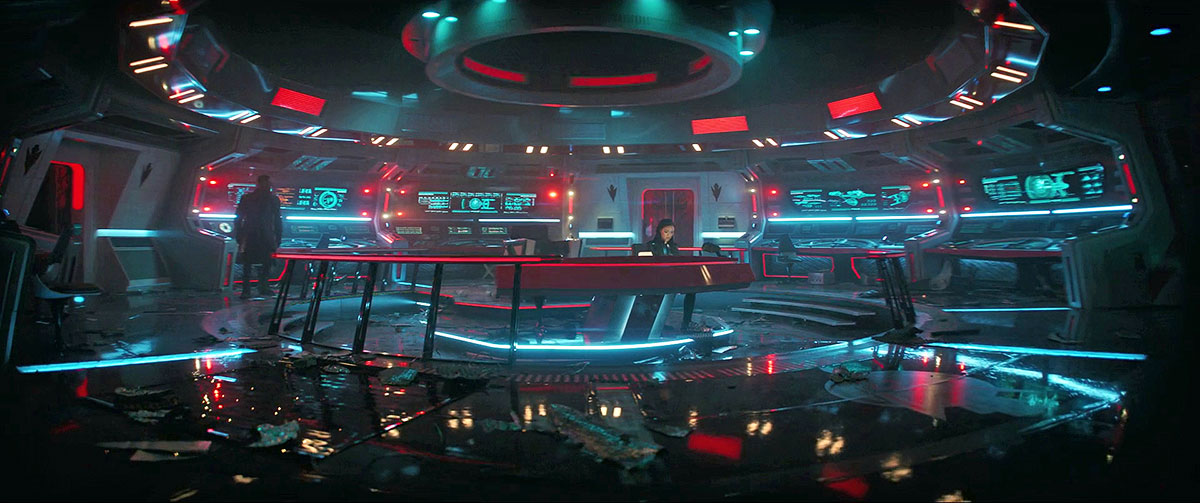
Okay, Enterprise time. Burnham and Book rightly surmise that this is where Moll and L’ak must have escaped to and beam to the ship, which of course turns out to be a redress of the Strange New Worlds standing sets. A quick scan identifies that no one else is aboard — though the clue, which Moll and L’ak have found, does also have a lifesign, hmm — and that Moll and L’ak are holed up in sickbay. Burnham takes a few moments to ponder her visit to the Mirror Universe back in Season 1 and wonder what the alternate version of her half-brother Spock might have been like (bearded, for one).
And aside from some brief storytelling about Mirror Saru’s role as a rebel leader, that’s about it for the Terran Empire of it all. Star Trek: Discovery has spent plenty of time in and around the Mirror Universe already, and I personally don’t think they need to revisit it again. But introducing the ISS Enterprise — the ship that started it all with The Original Series ’ “Mirror, Mirror” — and then not doing anything momentous with it? Strange decision, and one that makes it ultimately feel more like this was a way for the show to get to reuse a set on the cheap than it does a materially significant addition to the episode.
In fact, in some ways it’s actually a detriment to the episode. If the action had been set on any other ship it would have been fine, but being on the ISS Enterprise I kept expecting something — like seeing Paul Wesley as Mirror Kirk slinking around, or finding Anson Mount camping it up as Mirror Pike in a personal log. If they’d set the action on a generic derelict ship, what we got wouldn’t have seemed like a let down. As it is though, I kept waiting for the other shoe to drop… and it simply never did.
Maybe in a subsequent episode, it’ll turn out that there’s an advantage in having an entire functional starship composed of atoms from another universe at Starfleet’s disposal — or to have a convenient collection of Constitution -class sets available for that Starfleet Academy show to borrow once in a while — but until that happens (if it even does) the use of the ISS Enterprise just seems like a name drop and a “We have to set the action somewhere , why not here?” instead of a significant use of the setting and the huge amount of lore and history that comes with it.
It’s like setting something aboard the Titanic without ever mentioning any icebergs.
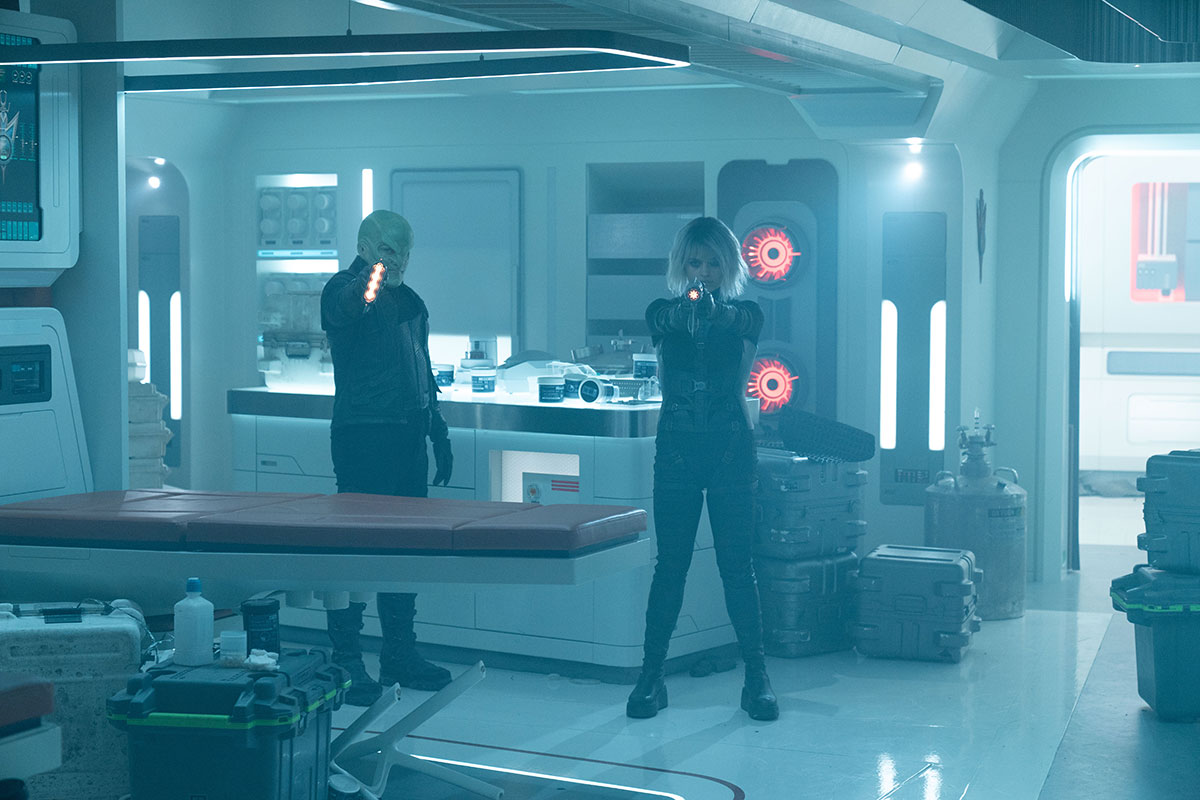
As Burnham and Book make their way down to sickbay they do find evidence that the ship was being used in a way that seemed unusually gentle for a Terran Empire vessel: signs that children and families were aboard at one time, and that they were the kind of people sentimental enough to have keepsakes and favorite stuffed animals. But again, nothing about this seems like it needs the Mirror Universe connection. Ships of people trying to escape adversity are already a Star Trek staple.
Burnham and Book find Moll (Eve Harlow) and L’ak (Elias Toufexis) in sickbay, and after a valiant but ultimately unsuccessful attempt at getting them to surrender, everyone starts shooting. Moll and L’ak have a Breen blood bounty — an erigah — on their heads and surrender is simply not an option. During the firefight a lockdown is triggered, forcefields coming down that split the group into pairs: Burnham and L’ak stuck in sickbay, while Book and Moll able to go back to the bridge to try and reset sickbay.
Pairing off also gives Book the opportunity to continue his efforts to connect with Moll, and I have to say, I don’t think I’m a fan. Setting aside the portion of this that’s purely a strategic attempt to forge a connection with someone who is very to keen to kill him, my first reaction to the way Book talks to Moll about her father (and his mentor) was distaste.
I don’t think Book meant it this way, but the way he’s written in these scenes feels unpleasantly close to the “Well, he was a great guy to me , I never saw him do anything bad” response that’s sometimes made to accusations of misconduct. A person can be wonderful to some people in their life and terrible to others; both experiences are true for the people who received them, but they’re not mutually exclusive.
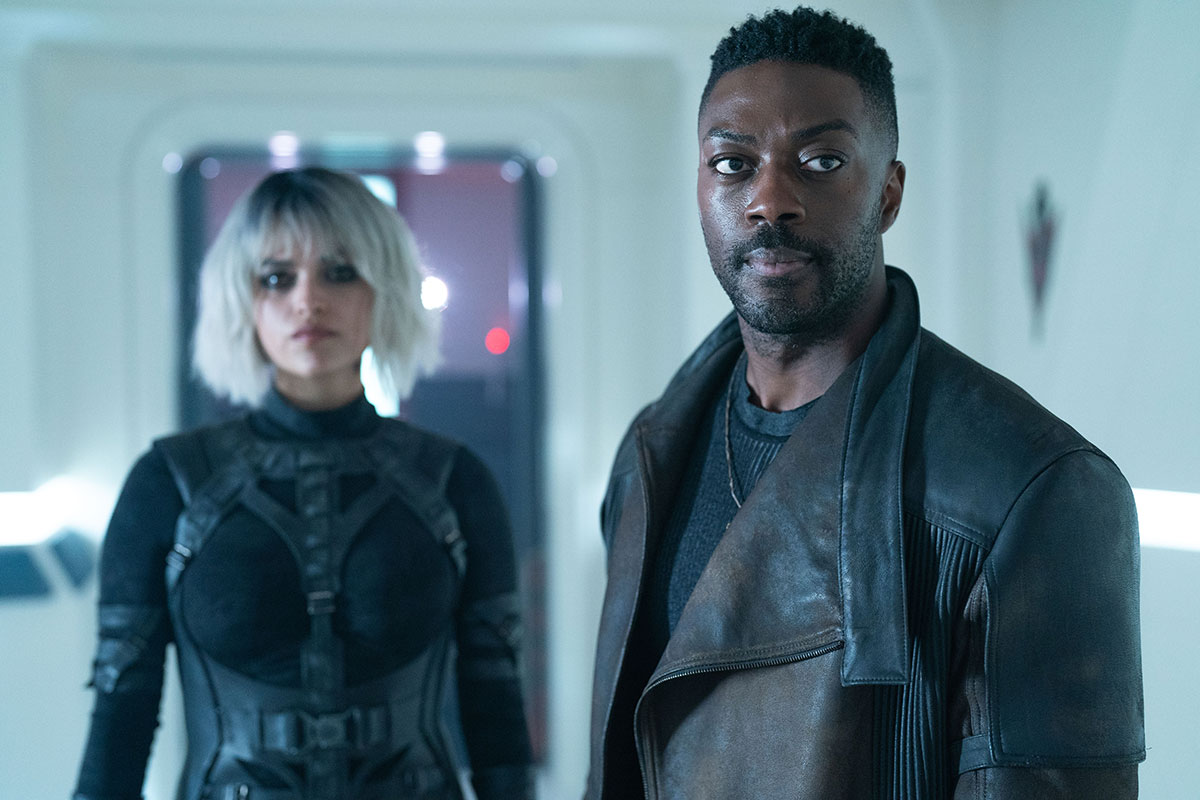
Book is preternaturally empathetic, and yet he doesn’t seem to see how continually assuring Moll that her father loved her is an act that’s both unwanted and actively painful for Moll to hear. I understand that Book is just trying to bring a sliver of comfort to Moll – but in the process he’s dismissing her own experiences of her father and his place in her life. Unless Moll asks him for this, it’s really none of Book’s business.
I suspect they’re setting up Moll’s character for a nice, cathartic arc where she comes to terms with her life, forgives her father, releases her past, whatever. And when that happens in real life that’s great — but it doesn’t always, and that’s okay too. If Moll never sees in her father the man Book saw in his mentor, it’s not a character failing. Discovery is really hammering home the theme of confronting one’s past in order to take control of one’s present and future, and I think it would be valuable if they included an example of a character learning to do the latter… without having to be okay with the former.
And to return to a question I posed in my review of “Under the Twin Moons,” I know Book is isolated and excruciatingly lonely after the destruction of Kweijan and his split with Michael, but the weight he’s placed on his relationship with Moll as “the closest thing he has to family” seems like he’s setting himself up for disappointment. Maybe I’m just a cynic, but this does not feel like a hopeful storyline to me. Not everyone wants to be family, and right now it doesn’t seem like Moll’s been given much of a choice in the matter — despite her frequent and very powerful explanations of why she’s not interested.
Clearly frustrated with Book’s topic of conversation and desperate to return to L’ak, Moll makes a reckless decision to brute-force a solution and overload some circuits. It works, and the forcefields in sickbay come down, but it also sends the Enterprise onto an unstoppable collision course with the too-small-to-pass-through and also going-to-be-closing-forever-soon wormhole. They’ve got eight minutes to figure this out.

Meanwhile aboard Discovery , we see Rayner’s struggles to interact with the crew. This thread could have gone so many different ways, Rayner seeming “too good” for a temporary command, him seeing this as his chance to do things “better” than Burnham or show how it’s “really done,” but instead the show takes the much more subtle and satisfying route: Rayner is deeply respectful of the captaincy, as a rank and a role, and really doesn’t want to step on Burnham’s authority.
He’s more than willing to disagree with her on command decisions , but he doesn’t question her command . And more personally, he doesn’t want his gruffness and lack of experience with this crew to cause problems. He’s trying, in his own Rayner way, and more importantly he’s succeeding — and, as we see as he shepherds the crew through figuring out how to communicate with and then rescue Book and Burnham, the crew does their part and meets him halfway.
Rayner is learning that he needs to tone down his temperament just enough that he doesn’t come across as an actual asshole to this crew, and the crew is learning that his gruffness isn’t a sign of disrespect but simply a desire to cut to the chase and get to direct, actionable information with a minimum of fluff. There are shades of Nimoy’s Spock or Voyager -era Seven of Nine here, but couched within a distinctly different temperament, and it’s fascinating to watch. I’d love to have seen him interacting with the crew of the Antares , where he presumably felt more comfortable.
The interpersonal stuff with Rayner and the crew is great; where Rayner’s thread feels distractingly like a box being checked is the explosion of “Rayner is a Kellerun!” being shouted from the bulkheads. I could practically hear the writers yelping out a panicked “Oh crap, we forgot to say what kind of alien Rayner is!”
Again, Discovery is back to its old self with the clunky, heavy-handed, and oddly paced character work. Rayner goes from having zero cultural touchstones to having about five in the span of the 15-20 minutes of screentime that his story gets this week. They’re good touchstones, don’t get me wrong — I’m skeptical of Kellerun citrus mash, I have to be honest, but I’d give it a try; not so sure about boiling a cake though — they’re just very present .
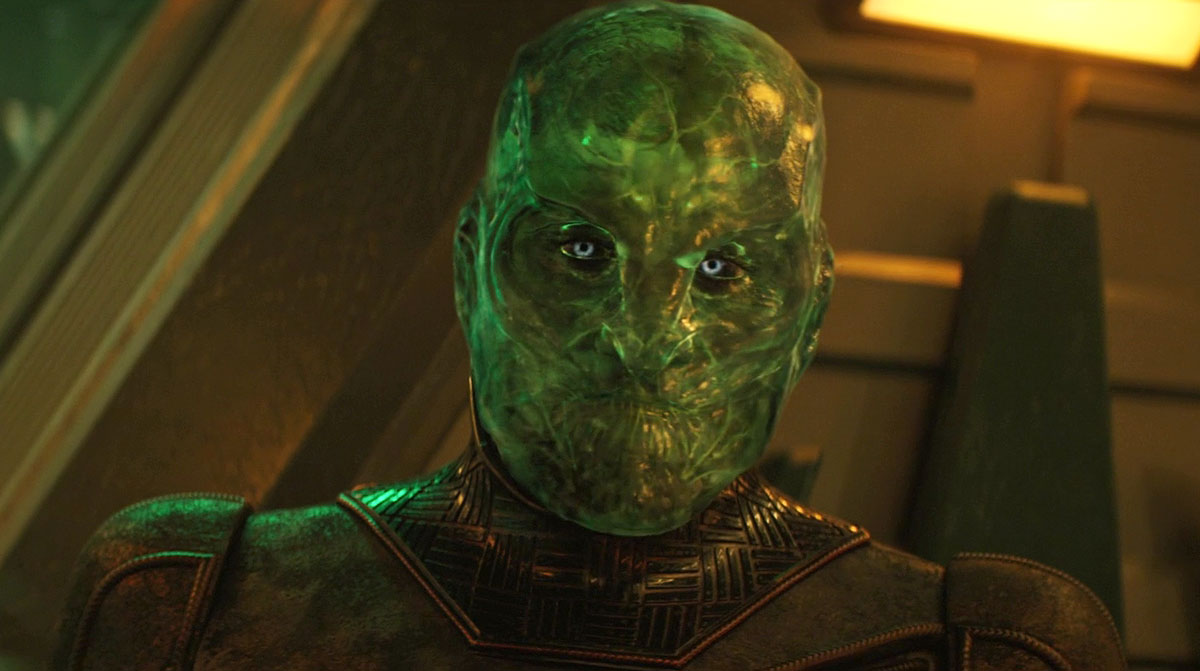
As with Rayner’s alienness, the frequent flashbacks throughout the episode to Moll and L’ak’s meeting and courtship feel like a “We forgot to explain this and now we’re trying to reference it!” correction. The content of the flashbacks is fine, there’s a lot of interesting Breen worldbuilding for a species that’s been mysterious from the start — and watching Moll and L’ak’s relationship grow from one of mutual convenience to one of true love is genuinely moving. But the way it’s woven into an episode that, again, feels like it’s composed of bits and pieces of storyline, makes it hard to shake the sense that I was watching a To Do list get checked off.
By the time the season is over it might be clear that there was simply no extra room to give a full episode over to Moll and L’ak’s meeting, or maybe an episode without any of the main cast wasn’t something they were willing or contractually able to do, but I would have loved if these flashbacks were pulled out and expanded into a full-length episode of their own. Some of the worldbuilding felt hasty to the point of hindering the emotional beats — at times I wondered if I’d forgotten a whole bunch of Breen lore and at others I was just trying to keep up with what was going on.
For example, my confusion about L’ak’s comment about having two faces, which Moll seemed to completely understand — “Duh, everyone knows the Breen have two faces” — was a distraction in the middle of an otherwise nice and significant moment. This is later clarified as the translucent face and the solid face, but again I was distracted from fully appreciating an interesting bit of Breen culture because I was busy applying what I’d just learned back to the previous scene.
The quickly (and maybe not totally clearly articulated notion) that Breen deliberately restrict themselves to their translucent form for reasons that are entirely to do with avoiding any perception of weakness is a potent if hasty bit of social commentary, and as I said I nearly didn’t catch it.
Whether holding the translucent form requires the armor for protection or the armor necessitates the translucent form — it seems like it would be more comfortable wearing that helmet all the time if you were the texture and consistency of lime jello — this is surely a metaphor for the increasingly rigid, isolating, and emotionally and sometimes physically unhealthy things men in certain circles feel they must do to be appropriately masculine. Seeing L’ak free himself from that rigidity is powerful.
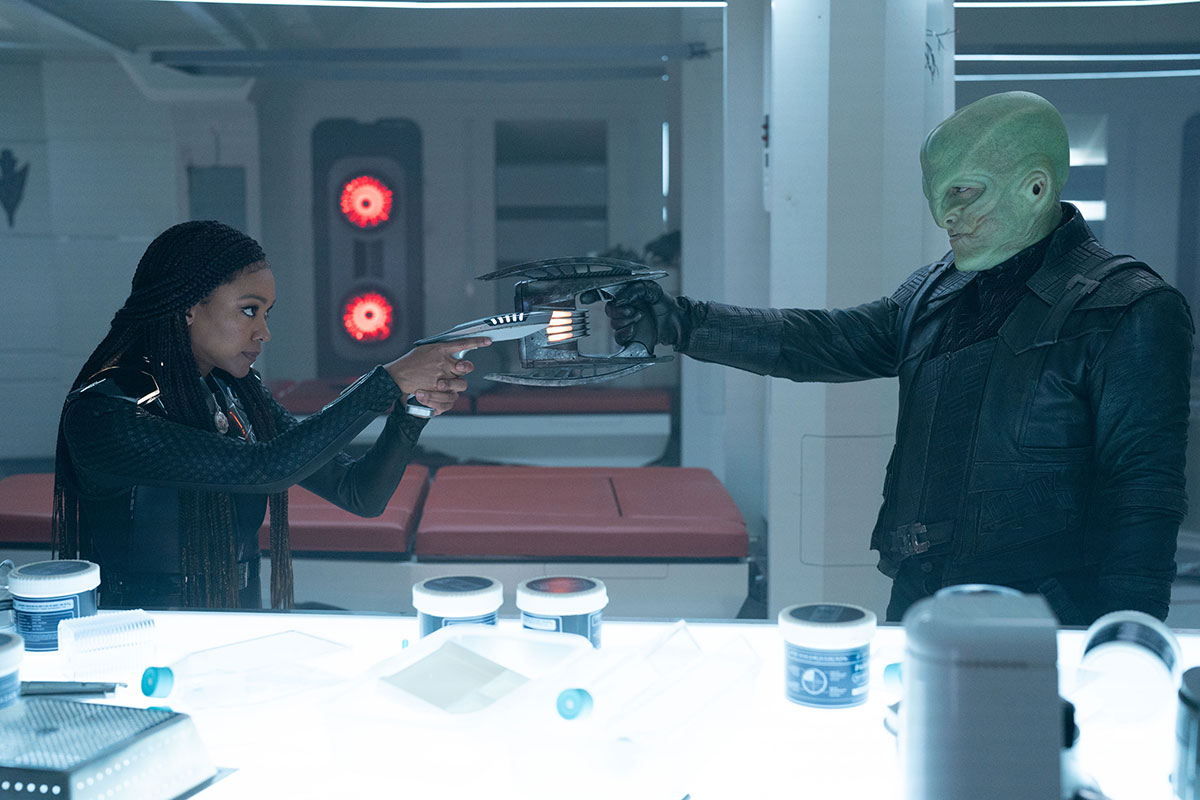
With the forcefields in sickbay down, Burnham and L’ak immediately spring into action: Burnham trying to get the artifact from L’ak and L’ak simply trying to get away. They fight, and Burnham impressively proves she can hold her own against a Breen. When L’ak accidentally falls on his own blade, Burnham grabs the clue and speeds to the bridge where she manages to get a message to Rayner through some tractor beam trickery. The message? Another reference to that classic of Kellerun literature that gives Rayner the info he needs. Hey, did you know Rayner was a Kellerun?
The ISS Enterprise makes it through the wormhole, Moll and L’ak zip away in an escape pod, and it’s time to wrap things up. We head to Red’s for a quick but significant moment between Tilly (Mary Wiseman) and Culber (Wilson Cruz), as Tilly offers advice and an ear to a Culber who’s going through a quiet existential – maybe also spiritual? – crisis.
OBSERVATION LOUNGE
- In addition to the dedication plaques on the bridge, the ISS Enterprise has an additional plaque in its transporter room — one which, despite recounting the heroism of rebel action hero Mirror Saru, still states “Long Live the Empire.”
- The transporter room plaque is marked with “Stardate 32336.6,” which is about 9 years before the events of “Encounter at Farpoint.”
- The plaque describes the fate of Mirror Spock, who was killed after instituting the reforms which later led to the fall of the Terran Empire (as described in DS9’s “Crossover”).

The full text of the ISS Enterprise transporter room plaque:
The new High Chancellor presented hope and justice as if they were natural to our world. His words, “The light of hope shines through even the darkest of nights” became our rallying cry. He spoke of reform, and changed many of us. But some saw this as weakness. They killed him, and we sought help from an unlikely ally: A Kelpien slave turned rebel leader. He spoke of visitors from another world… a near perfect mirror cast our darkness into light. With his aid we secured the Enterprise and stayed behind to continue his work. We bear scars from our escape, but our hope remains. May it carry us into a pristine, peaceful, and just future.
- Not counting L’ak’s previous appearances this season, this episode marks the first time we have seen the Breen in live action since their involvement in the Dominion War in Deep Space Nine. (The species has appeared in Star Trek: Lower Decks three times.)
- The 32nd century Breen wear updated encounter suits clearly based on the designs introduced in Deep Space Nine ; their digital speech is extremely faithful to the incomprehensible noises Breen soldiers have spoken in past appearances.
- Given the fact that Moll appears to be just fine in the environment of the Breen ship, I guess Weyoun was right when he said the Breen homeworld was “quite comfortable” in “The Changing Face of Evil.”
- When L’ak is stabbed he gently oozes some green goo — but as we learned in “In Purgatory’s Shadow,” Breen do not have traditional humanoid blood.
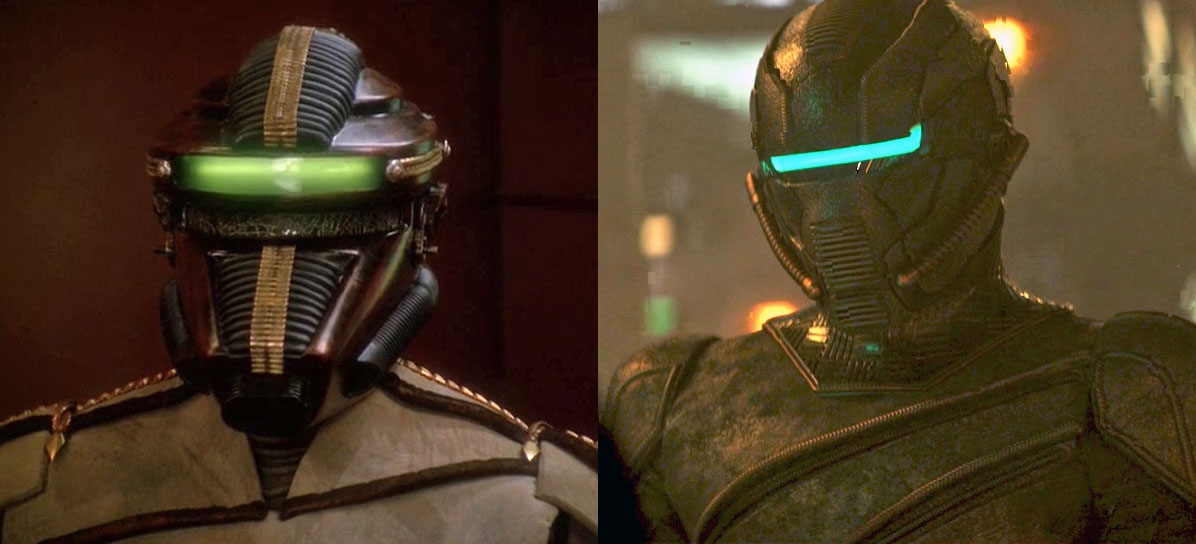
- During his time in command of Discovery , Rayner never sits in the captain’s chair.
- This episode closes with a dedication plaque that reads “In loving memory of our friend, Allan ‘Red’ Marceta”. Marceta was, I presume, the namesake for Discovery’s bar.
- Someone aboard Discovery keeps a Cardassian vole as a pet. Going by Tilly’s reaction, and what we know from Deep Space Nine , this is not a good thing.
- Linus (David Benjamin Tomlinson) plays a mean piano.
- Owosekun and Detmer get the off-screen cherry assignment of flying the ISS Enterprise back to Federation Headquarters, alone. I’m thinking that’s going to inspire some fanfic…

We don’t learn what this week’s clue is, though we know there’s a blue vial tucked away inside it, but we do learn that the crew of the ISS Enterprise did indeed make it to our universe. The scientist responsible for hiding this particular clue there was one of them, a Dr. Cho, who eventually made it all the way to branch admiral.
They strove for something positive and succeeded against all odds. Hopefully Discovery will be able to do the same as they continue their pursuit of Moll, L’ak, and the Progenitors.
Star Trek: Discovery Season 5 returns with “Whistlespeak” on Thursday, May 2.
- DSC Season 5
- Star Trek: Discovery
Related Stories
New star trek: discovery photos — “mirrors”, interview — sonequa martin-green on burnham’s “face the strange” encounter, star trek: discovery review — “face the strange”, search news archives, new & upcoming releases, featured stories, lost-for-decades original star trek uss enterprise model returned to roddenberry family, star trek: lower decks cancelled; strange new worlds renewed for season 4, our star trek: discovery season 5 spoiler-free review.
TrekCore.com is not endorsed, sponsored or affiliated with Paramount, CBS Studios, or the Star Trek franchise. All Star Trek images, trademarks and logos are owned by CBS Studios Inc. and/or Paramount. All original TrekCore.com content and the WeeklyTrek podcast (c) 2024 Trapezoid Media, LLC. · Terms & Conditions

Behind-the-Scenes of Star Trek: The Dual Role Elinor Donahue Embodied in “Metamorphosis”
E linor Donahue’s contributions to the “Metamorphosis” episode of Star Trek went beyond her on-screen character. Unbeknownst to many viewers, she provided an off-camera role that was crucial to William Shatner’s performance. Director Ralph Senensky enlisted her help just as she was preparing to leave the set:
“I was there and I don’t quite know why I was there. Maybe I’d shot something in the morning and was released for the rest of the day. It was near lunch time and I’d decided to go have lunch. They started to set up for that scene and I believe it was the director, who said, ‘Would you mind, if you’re going to be here, but you don’t have to be, climbing up on the ladder and reading the lines?’ I said, ‘Oh, I’d love to.’”
For the dialogue with the Companion, Donahue ascended a ladder to provide Shatner with someone to interact with, enhancing the authenticity of his reactions. Her perspective on this unexpected role was positive:
“I thought it was wonderful fun, because there was no pressure on me to perform anything, so to speak. It was just an opportunity to be helpful to a fellow actor, and, yes, [Shatner] was very appreciative. He seemed to smile and be very happy about my being up there.”
Ultimately, Elinor Donahue was one of three individuals to give life to the Companion, with Elizabeth Rogers first voicing the character, followed by Lisabeth Hush after Rogers’ performance did not meet the director’s expectations. Post-Star Trek, Donahue’s career in television thrived continuously.
FAQ: Elinor Donahue in “Metamorphosis”
Why did Elinor Donahue end up playing the off-camera role of the Companion?
Donahue was present on the set and was approached by the director to provide the lines for William Shatner’s scene partner.
Who ultimately voiced the Companion in the episode?
The final voice for the Companion in the episode was provided by Lisabeth Hush, after Elizabeth Rogers was replaced.
Did Elinor Donahue play the role of the Companion on screen?
No, Elinor Donahue’s role was off-camera to assist Shatner during the scene, and the voiced performance of the Companion was done by others.
Elinor Donahue’s impromptu second role in the “Metamorphosis” episode of Star Trek exemplifies the unforeseen tasks actors may undertake behind the scenes. Donahue provided an essential albeit unseen performance that contributed to the final product of the episode, showcasing the collaborative effort that is often needed in television production. Her flexibility and willingness to help a fellow actor make for an interesting note in Star Trek history, further enriching the series’ storied behind-the-scenes lore.

Star Trek’s Michael Dorn Wanted Worf To Kill A Popular Deep Space Nine Character In Picard Season 3, And I’m Glad This Didn’t Happen
I'm breathing a sigh of relief.
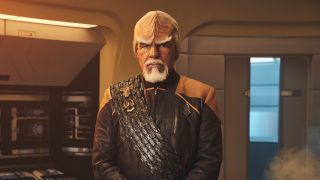
Although Star Trek: Picard Season 3 reunited most of the Star Trek: The Next Generation starring actors for the first time since 2002’s Star Trek: Nemesis , they didn’t all show up at once. In the case of Michael Dorn’s Worf , his first scene in the episode “Disengage” saw him rescuing Michelle Hurd’s Raffi Musiker from the crime lord Sneed, and he beheaded the Ferengi on his way out. But if Dorn had his way, he would have killed a different Ferengi instead: Quark, one of the other major characters from S tar Trek: Deep Space Nine , and I’m glad this didn’t happen.
Armin Shimerman, who played Quark for the entirety of Deep Space Nine ’s seven-season run, shared this tidbit of information while appearing on TrekMovie ’s All Access Star Trek podcast. Dorn came aboard Deep Space Nine at the beginning of Season 4 following The Next Generation’s conclusion, so he and Shimerman spent a lot of time together in the mid-late ‘90s, but decades later, the latter wasn’t particularly enthused about the former wanting to slice Quark’s head off. As he recalled:
Dorn called me up and said, ‘I’m doing an episode of Picard where I kill off a Ferengi. Wouldn’t it be great if it were you?’ I said, ‘Michael no, it would not be great.’ I told him just to forget about that idea altogether.
Jonathan Frakes , who was also a guest on this episode, speculated that Michael Dorn didn’t know Worf would be cutting Sneed’s head off, but Armin Shimerman told the William Riker actor and longtime Star Trek director that, at the very least, Dorn was aware Worf was going to kill a Ferengi. In the end though, it was Sneed who met this fate, with the character being played Aaron Stanford, who previously worked with showrunner Terry Matalas on the 12 Monkeys TV show.

Star Trek: Picard's Showrunner Reveals The True Purpose Of The Show's Ending, And It Actually Makes Me Optimistic About A Follow-Up
Star Trek: Picard Wrapped Up The Story For Patrick Stewart’s Character, But Now He May Be Getting A New Movie, And I Have Mixed Feelings
I am so relieved this Quark idea for Star Trek: Picard never came to fruition. Worf killing off a Ferengi criminal lord mere minutes after we meet this character is one thing, but for him to behead a character that not only is beloved by many Star Trek fans, but whom Worf had known for many years is another. Granted, as Dr. Julian Bashir once said, Quark was definitely not Worf’s “favorite person,” and he tried to steer clear of the bar owner whenever possible. But not only do I not believe that Quark would ever become a crime lord on Sneed’s level, I also don’t buy that Worf would have just killed his former… associate without blinking an eye.
If the day comes that Armin Shimerman reprises Quark in live-action, the character needs to be treated with the proper respect and not just be killed off for shock value. Star Trek: Lower Decks had the right idea, as Shimerman voiced Quark for a meaningful role in the Season 3 episode “Hear All, Trust Nothing.” The fan-proposed Star Trek: Legacy would be the best place for that to happen, though there’s still no word if that project stands a chance of becoming one of the upcoming Star Trek TV shows .
Picard , Deep Space Nine and all the other Star Trek shows (except for Prodigy , which is now at Netflix ) can be streamed with a Paramount+ subscription . Discovery is currently in the midst of its final season, and Lower Decks ’ final season will follow sometime afterwards on the 2024 TV schedule .
CINEMABLEND NEWSLETTER
Your Daily Blend of Entertainment News

Connoisseur of Marvel, DC, Star Wars, John Wick, MonsterVerse and Doctor Who lore, Adam is a Senior Content Producer at CinemaBlend. He started working for the site back in late 2014 writing exclusively comic book movie and TV-related articles, and along with branching out into other genres, he also made the jump to editing. Along with his writing and editing duties, as well as interviewing creative talent from time to time, he also oversees the assignment of movie-related features. He graduated from the University of Oregon with a degree in Journalism, and he’s been sourced numerous times on Wikipedia. He's aware he looks like Harry Potter and Clark Kent.
Disney+ Dropped A Pic With Jeremy Allen White, Tom Hiddleston And Logan Lerman All Suited Up, And The Fanbases Are All Uniting To Stan
I Got To See The Idea Of You In A Theater And I Wish Everyone Could. Turns Out, Anne Hathaway Has Thoughts Too
How Ramy Youssef Is Already Becoming One Of Hollywood's Brightest Stars
Most Popular
- 2 With Chicago P.D. Finale Approaching, Dick Wolf Television Is Heading Down South For New Crime Series
- 3 Why Bob Hearts Abishola Star Billy Gardell Thinks The Ending Needs To Be Like Mike And Molly
- 4 I Watched The Bluey Episode "The Sign": Why I Think The Show Should Stick With Longer Episodes From Now On
- 5 Shōgun’s Director Talks About Filming Episode 9’s Spoilery Death Scene, And How A Positive COVID Test Almost Derailed The Whole Thing

- View history
B-4 was a prototype Soong-type android constructed by Doctor Noonien Soong on Omicron Theta during the 2330s . He was one of three failed prototypes , and the only one to survive a significant amount of time after his activation, before the construction of Lore was successful. ( TNG : " Inheritance ") Although B-4 was outwardly identical to both Data and Lore, the two final androids built, B-4 was not equipped with a positronic brain as sophisticated as those of his brothers. As a result, he had difficulty understanding simple concepts and processing information.
The existence of B-4 was not known to Starfleet until 2379 , when the disassembled pieces of the android were found by the crew of the USS Enterprise -E on Kolarus III , although he could not remember anything about his existence prior to Kolarus III or how he ended up there. The crew of the Enterprise subsequently reassembled him. Although he recognized B-4's limitations, Data wished to give his brother the opportunity to expand his capabilities, much in the same way that he himself had in years past. To that end, Data willingly copied all of his memories to B-4, hoping that the added experiences would help B-4 expand beyond his original programming. However, he was unable to immediately assimilate Data's memories and could not remember things Data could, such as the layout of the Enterprise , Dr. Soong, or Captain Jean-Luc Picard .
In actuality, B-4's pieces had been planted on Kolarus III by Shinzon as part of an elaborate scheme to lure Captain Picard near Romulan space in order to capture him. B-4 was also used as an unwitting spy; he was equipped with a second memory port that contained subversive programming that compelled him to download vital information about the positions of all Federation starships and their coded communications frequencies. However, Data and Lieutenant Commander Geordi La Forge discovered B-4's unauthorized access and indefinitely deactivated him. Data posed as B-4 and provided Shinzon with inaccurate locations for all Starfleet vessels as well as assisting Captain Picard in escaping from Shinzon's ship, the Scimitar .
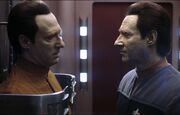
Data deactivates B-4
A short time later, Data perished while destroying the Scimitar , having voluntarily sacrificed himself to save Captain Picard. B-4 was reactivated so that Picard could tell him of his brother's death, but Picard sadly departed the meeting when his attempts to explain what Data meant to them only confused B-4. With his future uncertain, Picard had noted some of Data's downloaded memories beginning to surface as B-4 began to sing the song " Blue Skies ", which Data had performed at Will Riker and Deanna Troi 's wedding . ( Star Trek Nemesis )

B-4's disassembled parts
By the 2390s , B-4 had been disassembled, and was placed in storage at the Division of Advanced Synthetic Research at the Daystrom Institute . His components were visited in 2399 by Picard, after his retirement . According to Dr. Agnes Jurati , B-4 was " not much like Data at all, " and most of Data's positronic network was lost after the transfer. ( PIC : " Remembrance ") B-4's disembodied head was later moved to Daystrom Station . ( PIC : " The Bounty ")
Following the lifting of the ban on synthetics, Altan Soong began construction on a new golem that would serve as a 'totality', combining parts of B-4, Lore, Lal, and a large amount of Data into a singular being. He gave the new golem an older appearance, based on an aged Soong, hoping to reflect the wisdom of age. While Data's positronic network had previously been unrecoverable from B-4, the lifting of the ban allowed Soong to further his work into the effort and eventually extract Data from B-4's head. However, Soong died before he could complete this golem, and Starfleet seized his work, storing it at Daystrom Station . The integration appeared to have failed, and the four personalities were at odds with each other inside the golem. While interviewing the golem aboard the USS Titan , the voice and personality of B-4 briefly manifested right after Data and Lore's manifestations before then being cut off by Alton Soong's personality. ( PIC : " The Bounty ") Geordi La Forge discovered that B-4's personality profile was memory data only rather than a full personality, as Data and Lore were. ( PIC : " Dominion ") After taking full control of the android, Data told La Forge that he was Data, but also Lore, B-4, and everything else that Dr. Soong programmed into it. ( PIC : " Surrender ")
- 1.1 Appearances
- 1.2 Background information
- 1.3 Apocrypha
- 1.4 External link
Appendices [ ]
Appearances [ ].
- Star Trek Nemesis
- " Remembrance " (disassembled body)
- " The Bounty " (disassembled head)
Background information [ ]
B-4 was played by actor Brent Spiner .
According to the original Star Trek Nemesis script , the android B-4 ("before") was named "B-9" ("benign"). After detecting the positronic signature from Kolarus III, La Forge asks Data how many androids Dr. Soong built with Data replying he was only aware of himself and Lore . Also according to the script, the android was taken from its homeworld by the Pakleds and traded to the Bolians . He ultimately encountered some Cardassians , who tossed him into a garbage chute and out into space , where he was found by Talosians . It was also revealed that Shinzon had learned of the prototype android through a Cardassian historian. Shinzon had planned to force B-4 into slave labor after carrying out his plans against Picard and the Federation. None of this, however, made it to the final version of the film. The novelization of Star Trek Nemesis names him as "Be-Fore." A deleted scene from the film shows Data trying to teach B-4 to eat with a spoon in the Enterprise crew lounge, but he cannot grasp the skill, much to Data's disappointment.
B-4, Dimitri Valtane , Lojur , the Borg Queen , Hayes and the Punk on Bus are the only characters to debut in a Star Trek film before appearing in a Star Trek television series.
Apocrypha [ ]
B-4 is deactivated and sent off to the Daystrom Institute for Analysis in the novel Resistance , Picard and La Forge having come to accept that the moments where B-4 acts like Data are merely random sparks rather than any sign that B-4 has significantly progressed as a sentient being.
In the novel Cold Equations : The Persistence of Memory , Doctor Bruce Maddox is contemplating deleting Data's memory engrams from B-4, who is kept in storage along with the remains of Soong's other prototype, Lore , and Lal , Data's daughter, when they are stolen by the Breen . Doctor Soong – who survived his death by transferring his mind into an android body far more Human in appearance than Data's – manages to recover his "children", and transfers Data's memories from B-4 into his own body, unable to complete the new body he had been attempting to construct for his "son". The new being is known as 'Data Soong', and retains the memories of Soong alongside Data. He chooses not to rejoin Starfleet, instead forging a new path, buoyed by Soong's substantial wealth. Subseuqently, in Cold Equations : The Body Electric , Data Soong restores Lal to life.
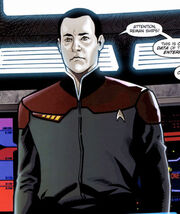
Captain Data - Data's neural nets in the body of B-4
The comic book series Star Trek: Countdown (a tie-in to the 2009 Star Trek film) and the timeline established for the Star Trek Online game depict Data as being alive in 2387 . Sometime prior, Geordi La Forge installed Data's emotion chip into B-4's neural net. This caused the uploads to B-4 by Data to fully activate, allowing Data's full memory and personality to assert itself, essentially resurrecting him. Starfleet decided to reinstate the android to service and, by the time of Countdown, Data had become captain of the USS Enterprise -E . The reactivated Data and Spock later converse on their respective "resurrections."
The "Guardians" story in Strange New Worlds VII dealt with the Horta culture being transplanted to the planet where the Guardian of Forever resided. The Crystalline Entity visited the world almost a thousand years after the events of Nemesis and described an encounter where it was forced to destroy B-4.
External link [ ]
- B-4 at Memory Beta , the wiki for licensed Star Trek works
- 3 ISS Enterprise (NCC-1701)
Screen Rant
Fallout theory reveals that character will transform into the show's biggest missing monster.
If a clue in the Fallout season 1 finale is any indication, a major character may be transforming into the show's biggest missing monster.
- Thaddeus injected with serum from West-Tek likely becoming a super mutant, rather than a ghoul in the Fallout series.
- Fallout's lore suggests FEV serum as the reason for Thaddeus' transformation, not radiation exposure.
- Thaddeus turning into a super mutant would intensify conflict and make him a formidable foe in Season 2.
A Fallout theory postulates that Thaddeus will transform into a super mutant when the Prime Video series returns. Introduced as a member of the Brotherhood of Steel in Fallout's show , Thaddeus became a source of humor as he began acting as a servant to the person he once bullied. But as Fallout's story unfolds, it becomes apparent that Thaddeus' life will get much worse before he gets better. The series has strongly hinted that Thaddeus is about to undergo an unsettling transformation.
In Fallout episode 7, Thaddeus injected himself with a serum from an unscrupulous doctor. Due to what's known about the doctor, there was good reason to suspect that the injection wasn't at all what it appeared to be. Fallout supported that assumption when it revealed that Thaddeus had developed an inhuman resistance to injury. Maximus himself acknowledged that Thaddeus seems to be turning into one of Fallout's ghouls . But while this was the impression that Fallout gave, it's possible that the series is actually gearing up to turn him into a different creature, one that it teased but didn't fully introduce.
Why Does The World Of Fallout Look Like It's Stuck In The '50s?
Why thaddeus may turn into a super mutant in fallout season 2, thaddeus may have been injected with fev.
While it may be that Thaddeus is indeed in the process of becoming a ghoul, that's not the only Fallout monster that fits in with the show's setup for his transformation. In fact, it would make more sense if Thaddeus was changing into a super mutant instead. It's important to note that there's nothing in the pre-established lore that would explain how the serum could turn Thaddeus into a ghoul. Such a transformation is something that happens due to prolonged radiation exposure. While it can be induced by scientific means, Thaddeus' changes are happening a bit too fast to align with the current understanding of ghoul biology.
Thaddeus' ongoing transformation would, however, line up with what's been established about super mutants. In Fallout's world , super mutants were humans morphed into monsters by scientific experimentation. Some are the product of a formula called FEV (Forced Evolutionary Virus). After being injected with the FEV serum, test subjects would transform into super mutants . The liquid that the doctor gives Thaddeus being revealed as FEV would provide a working explanation for what the character is going through. Super mutants are incredibly resilient, so Thaddeus not feeling pain matches up with that detail in the show as well.
Fallout Already Teased The Creation Of FEV
Fallout's vault-tec meeting set up west-tek's plan to make super mutants.
The prospect of Thaddeus becoming a super mutant via FEV is made even more likely by a key scene in the Fallout season 1 finale . One of the characters in Fallout's Vault-Tec meeting is revealed to be Leon Von Feldon, an executive at West-Tek, one of the many science corporations in the universe of the games and the series. When Barb Howard tells the company representatives they can do with they want with their vaults and that no one will ask questions, each character brings up their own ideas, with Leon Von Feldon specifically mentioning an interest in producing " super mutant " soldiers.
This comment coming from a West-Tek executive may have major implications on Thaddeus' story. After all, it's West-Tek that designed FEV in the first place . FEV is how West-Tek made the super mutant monster, meaning that this is what the show is foreshadowing. Fallout choosing to reference the creation of FEV in particular here is telling, considering that in the episode prior, a character was injected with a serum that could very well have been the Forced Evolutionary Virus. The show choosing to highlight West-Tek's plans only bolsters the evidence for the theory that Thaddeus has FEV.
What Thaddeus Being A Super Mutant Could Mean For Season 2
Thaddeus will have the upper hand if he meets lucy or maximus again.
By making Thaddeus into a super mutant, Fallout would be able to pay off all its teases to the monster. Though super mutants are common opponents for the Vault Dweller in the Fallout games, the show has been carefully avoiding them thus far . The show certainly hasn't been oblivious to them, though, since there were a few moments where it appeared that Fallout was intentionally hiding them. For instance, there was a partially shown corpse in episode 2's Enclave scene that looked like a super mutant, but the show didn't linger on it.
Reserving the introduction of the super mutant for an existing character like Thaddeus would indicate that the series intends to make its debut a massive moment for the show. As for how it'll impact him physically, it goes without saying that Thaddeus would immediately become a force to be reckoned with . As a hulking powerhouse that can take bullet after bullet, a super mutant is a danger to any survivor in Fallout's apocalypse . They can be beaten, of course, but aren't easy to kill. With that in mind, Thaddeus could become a formidable villain in Fallout season 2 .
*Availability in US
Not available

COMMENTS
Lore was a Soong-type android constructed by Doctor Noonien Soong and Juliana Soong at the Omicron Theta colony. Built in Dr. Soong's own image, Lore was the fourth android they constructed and embodied the first successful example of a fully functional positronic brain. An earlier model Soong-type android protype, B-4, also had a positronic brain, but of a less sophisticated type, resulting ...
Lore is Data's evil twin brother and a recurring villain in "Star Trek: The Next Generation." Learn about his origin, his relationship with the Crystalline Entity, and his role in the "Picard" series.
Lore: Brent Spiner: Season 3 (PIC) Seasons 1, 4, 6-7 (TNG) Civilian: Android: L'Rell: Mary Chieffo: Seasons 1-2 (DSC) Chancellor: Klingon High Council: ... List of Star Trek characters with recurring roles: Actor(s) Character The Original Series (1966-1969) The Animated Series (1973-1974) The Next Generation (1987-1994)
Lore was one of the few guest characters to appear throughout the seven-season show, and his first appearance in Star Trek: The Next Generation season 1, episode 13, "Datalore" was a triumphant debut. The story saw the crew of the Enterprise reassemble Data's brother Lore, only to find that he had evil intentions and was in league with the Crystaline Entity.
Star Trek is a science fiction franchise comprising twelve television series, thirteen films, four companion series, numerous novels, comics, video games, reference works, podcasts, role playing games, along with thousands of collectibles. Originally, Star Trek was a product of Desilu Studios as created by Gene Roddenberry in a first draft series proposal "Star Trek is...", dated 11 March 1964 ...
Star Trek: The Next Generation fans might've been shocked to see Lore promoted as appearing in Picard Season 3, especially if they remembered his previous appearance on television. Lore was in ...
Lore is the evil android twin brother of Data, created by Doctor Soong. He has a complex emotional programming that makes him unstable and dangerous, and he has a long history of revenge and betrayal in Star Trek: The Next Generation.
When Data finally came to his senses and defeated and disassembled Lore, it seemed that was the end of the commander's twin brother, but Star Trek has a history of resurrecting popular characters. Lore returned for what may have been the last time in Star Trek: Picard, Season 3, as part of a new artificial lifeform comprised of the minds of ...
Lore is the surprise character Brent Spiner is playing in Star Trek: Picard season 3 after he portrayed Dr. Altan Inigo Soong and Dr. Adam Soong in the prior Star Trek: Picard seasons. Lore is evidently one of Picard season 3's main villains, along with Professor James Moriarty (Daniel Davis), who is also making a comeback from TNG, and a brand ...
Lore is a recurring character in Star Trek: The Next Generation, played by Brent Spiner. He is a prototype android brother of Starfleet's Lieutenant Commander Data (who serves as second officer cum science officer aboard the USS Enterprise). In Canon. Lore was created by Mad Scientist, Dr. Noonien Soong. Lore's emotional programming was very ...
Data is a fictional character in the Star Trek franchise.He appears in the television series Star Trek: The Next Generation (TNG) and the first and third seasons of Star Trek: Picard; and the feature films Star Trek Generations (1994), First Contact (1996), Insurrection (1998), and Nemesis (2002). Data is portrayed by actor Brent Spiner.. Data is a self-aware, sapient, sentient and ...
Star Trek: The Next Generation season 1 introduced Lore (Brent Spiner), the evil twin of Lt. Commander Data (Brent Spiner), and he would go on to cause trouble for the USS Enterprise-D on multiple occasions. In TNG season 1, episode 13, "Datalore," Captain Jean-Luc Picard (Patrick Stewart) takes the Enterprise to explore the planet Omicron Theta where Data was found.
Data was supposed to be the only one of his kind, so the arrival of a secret brother came as a surprise, and though Lore was in comparatively few episodes, his impact on the Star Trek universe was ...
Illyrians originate in the novel Vulcan's Glory, by Star Trek: The Original Series writer D.C. Fontana, which identified Number One as an Illyrian, with a numerical designation instead of a name. In the novel Child of Two Worlds, it was revealed that their government was a meritocracy, with aptitude testing used to select its officials.
NASA Astronaut Mae Jemison, shown here on a Space Shuttle mission, played a Lieutenant on the Enterprise-D. Physicist Stephen Hawking also appeared on an episode as himself.. This is a list of characters from the science fiction television series Star Trek: The Next Generation.Characters are ordered alphabetically by family name, and only characters who played a significant recurring role in ...
It was a vital TNG hour, and for several reasons. It, of course, introduced the character of Lore, Data's "evil twin," with Brent Spiner doing double duty as both Data and Lore. It was the last episode written by Star Trek creator Gene Roddenberry. It was the fourth of 13 TNG episodes directed by Rob Bowman and is considered both one of ...
Lore. For official blog entries from the official Star Trek Online website, see Lore Blogs. Below are the 166 questions and answers for the Path to 2409 daily trivia, available at Starfleet Academy from Commander Viala for "History 102: Alpha Quadrant Midterm" and Klingon Academy from Loresinger Ch'toh for "Learning the Lore of the Empire
Lore makes his return in Star Trek Picard season 3 episode 6. Sort of. It is revealed that Data's body was taken in by Daystrom, and that it was that reconfigured to act as the AI security system that protected Daystrom Station as an amalgamation of all of the Soong-type androids. This includes Lore, his personality, his intelligence, and his ...
El-Aurians were a spacefaring humanoid species originating from the El-Aurian system. A long-lived race of "listeners", they possessed perceptive abilities that extended beyond the normal space-time continuum. The El-Aurians were a widely traveled people who spread themselves across many parts of the galaxy and beyond. At least one El-Aurian, Guinan, visited Earth in 1893, before Humans had ...
Brent Spiner has portrayed various roles across the Star Trek universe, from members of the Soong family, his primary role as Data, and to a number of android brethren.. In celebration of Spiner's birthday, we're going to examine the line of Soong-type androids, created by Dr. Noonian Soong.These androids, possessing revolutionary positronic brains, includes two early prototypes, four ...
TNG character updates. The log for Jean-Luc Picard gives a good backstory but mostly covers what has been already seen in the first two seasons of Picard.However, the logs for the other TNG ...
"Mirrors" Star Trek: Discovery Season 5, Episode 5 - Debuted Thursday, April 25, 2024 Written by Johanna Lee & Carlos Cisco Directed by Jen McGowan. A solid episode with plenty of lore and ...
STAR TREK: DISCOVERY Review — "Mirrors". "Mirrors" is an episode whose parts are unfortunately greater than their whole: three stories that each needed to be told for the season to progress, but which all feel like a bit of an afterthought when combined together. Instead of loose threads woven into the tapestry of the season, they ...
Elinor Donahue's contributions to the "Metamorphosis" episode of Star Trek went beyond her on-screen character. Unbeknownst to many viewers, she provided an off-camera role that was crucial ...
Hugh (pronounced "Hue"), formerly Third of Five, was a former Borg drone who was rescued by the USS Enterprise-D in 2368. Once again joining the Enterprise to fight against rogue Borg led by Lore in 2370, by 2399 he had come to serve a prominent position as a part of the Borg Artifact Research Institute, identifying as an xB like those aboard the Artifact. Hugh was found in the Argolis Cluster ...
Michael Dorn reprised Worf in Star Trek: Picard Season 3, and he'd proposed having his character kill off a fellow Deep Space Nine alum. ... MonsterVerse and Doctor Who lore, Adam is a Senior ...
B-4 was a prototype Soong-type android constructed by Doctor Noonien Soong on Omicron Theta during the 2330s. He was one of three failed prototypes, and the only one to survive a significant amount of time after his activation, before the construction of Lore was successful. (TNG: "Inheritance") Although B-4 was outwardly identical to both Data and Lore, the two final androids built, B-4 was ...
The prospect of Thaddeus becoming a super mutant via FEV is made even more likely by a key scene in the Fallout season 1 finale.One of the characters in Fallout's Vault-Tec meeting is revealed to be Leon Von Feldon, an executive at West-Tek, one of the many science corporations in the universe of the games and the series. When Barb Howard tells the company representatives they can do with they ...